Warning: Undefined variable $k in /home/nginx/domains/wired2fishcom.bigscoots-staging.com/public/wp-content/themes/understrap-child-0.6.0/functions.php on line 984
Warning: Undefined variable $k in /home/nginx/domains/wired2fishcom.bigscoots-staging.com/public/wp-content/themes/understrap-child-0.6.0/functions.php on line 987
Bass fishing with Ned rigs is an incredibly effective way to catch bass. Although this fishing technique has been around for quite some time, it really busted onto the scene the past several years. Anglers throughout both the country and world quickly realized how many bass are easily fooled by this finesse technique.
Ned Kehde is widely considered the world’s foremost expert on this technique and is credited with being the father of the aptly named Ned rig. Quite the humble man, Kehde won’t take credit for it, but he has helped millions of anglers catch more fish with his unique tactics.
Kehde was gracious enough to share an extensive gear guide with us that details his must-have Ned rig baits and his observations and experiences with each. With all of the options out there these days, his descriptions and reasoning for choosing each bait will help you make a well-informed decision the next time you’re bass fishing.
“Since the 1950s, 1960s and 1970s, we have watched the forefathers of Midwest finesse fishing work meticulously to design and manufacture soft-plastic finesse baits, such as Chuck Woods Beetle, which was the first Senko-style bait, his Puddle Jumper and Guido Hibdon’s Guido Bug, which was the first soft-plastic crayfish,” Kehde said. “Woods and Hibdon anguished about the size of the torso and other features. They taught us that size is important. Therefore, our gear guides spend many words describing the size of each bait’s features.”
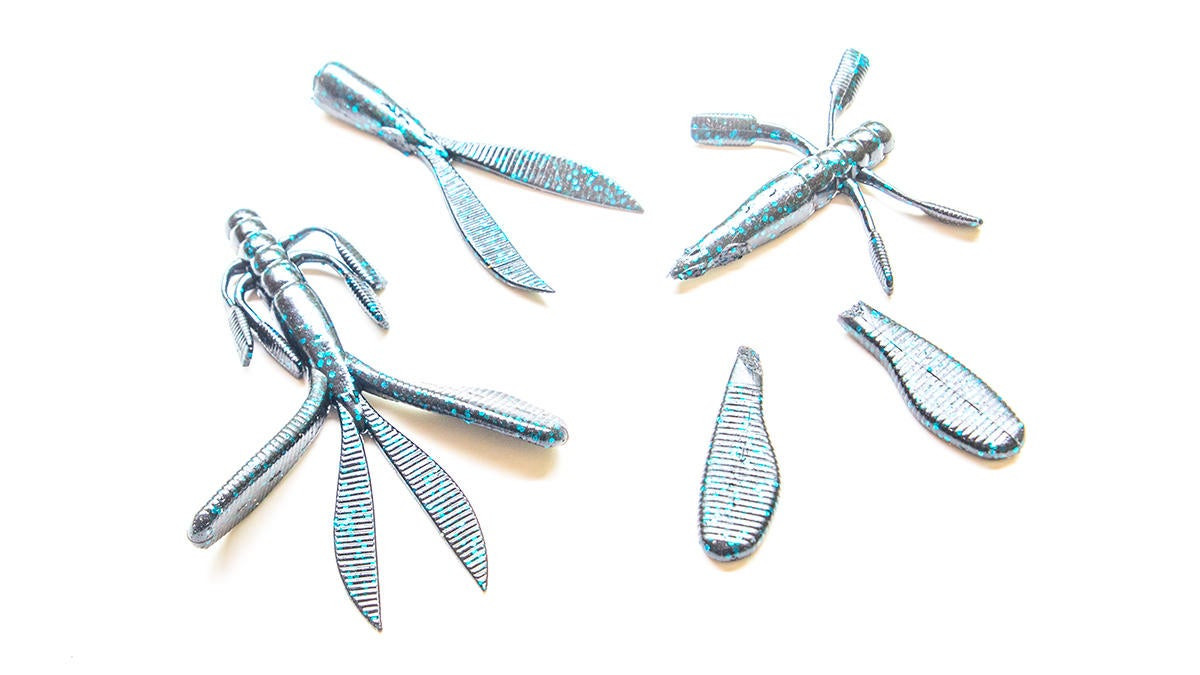
Berkley Mantis Bug
Berkley’s 4-inch PowerBait Mantis Bug is a multifaceted creature bait that was created for power anglers.
It was introduced to the angling world at the 2018 International Convention of Allied Sportfishing Trades (ICAST) show. Since then, it has caught the fancy of some Midwest finesse anglers who are inveterate customizers, and one of them convinced us to feature it in a Midwest Finesse gear guide.
Here is what we discovered about it.
It is 3 15/16 inches long.
The combination of its head and torso is 2 5/16 inches long.
The posterior portion of its torso, which is one inch long, is endowed with five major segments. The fifth segment, which is situated at the junction of the torso’s posterior and anterior sections, is a quarter of an inch long and seven-sixteenths of an inch wide with a circumference of about 1 3/8 inches. The other four segments are three-sixteenths of an inch long and five-sixteenths of an inch wide with a circumference of 1 1/8 inches. The tip of the first segment, which is where a hook is inserted, is flat, and it is a quarter of an inch high and five-sixteenths of an inch wide. The dorsal area of the torso is convexed and its ventral area is relatively flat, and its sides are relatively flat. The epidermis is smooth.
Two appendages radiate from each side of segments three and four of the posterior section. Each appendage is 1 1/8 inches long. The end of each of the appendages sports a rectangular-shaped feature that is a quarter of an inch wide and a half of an inch long. They are flat and embellished with a series of tiny ribs.
The anterior portion of the torso, which included its head, is 1 3/8 inches long. It is seven-eighths of an inch wide with a circumference of 1 3/8 inches near its junction with the posterior section. The dimension of the anterior section becomes increasingly smaller as it approaches the tip of the head. It exhibits an elliptical shape, and the tip of the head is somewhat similar to a sharpened wooden pencil. The ventral area is flat, and its dorsal is convex. The dorsal area of the head is embossed with two tiny eyes. The anterior’s epidermis is smooth.
About 3/4 inch from the junction of the anterior and posterior sections, a large, flat, and heavy appendage extends from each side of the anterior section of the torso. Each appendage is two inches long, 5/8-inch wide at the widest spot and 3/8-inch thick. About a half of an inch of its epidermis is smooth, and the rest of it, which encompasses 1 1/2 inches, is adorned with a series of minute ribs, which are similar to the tiny ribs that adorn the rectangular portions of the posterior’s four appendages. These two appendages are paddle shaped.
Another flat appendage branches out from each side of its head, which is adjacent to each eye. It is two inches long, 3/8-inch wide at its widest spot, and 1/16-inch thick. The entire dorsal side of each appendage is endowed with a series of minute ribs. The epidermis of the ventral area is smooth, but one of the appendages has the name Berkley embossed upon it. These two appendages possess somewhat of a knife shape.
It is manufactured in the following hues: Black Blue Fleck, Black Red Fleck, California, Green Pumpkin, Green Pumpkin Blue, Green Pumpkin Red, June Bug, Okochobee Craw, Perfection, South African Special, Sprayed Grass, Texas Craw, Watermelon, Watermelon Candy, Watermelon Red, and White.
It is infused with Berkley’s exclusive Powerbait formula, which, according to the folks at Berkley, is a scent that will provoke a black bass to hold on longer to it “up to 18 times longer than with standard soft-plastic baits.”
It is not buoyant.
After Midwest finesse anglers perform their various customization routines with the Mantis Bug, they will affix it to a small mushroom-style jig with an exposed hook. They will present it to their black bass quarries by employing the six standard Midwest finesse presentations or slight variations of them.
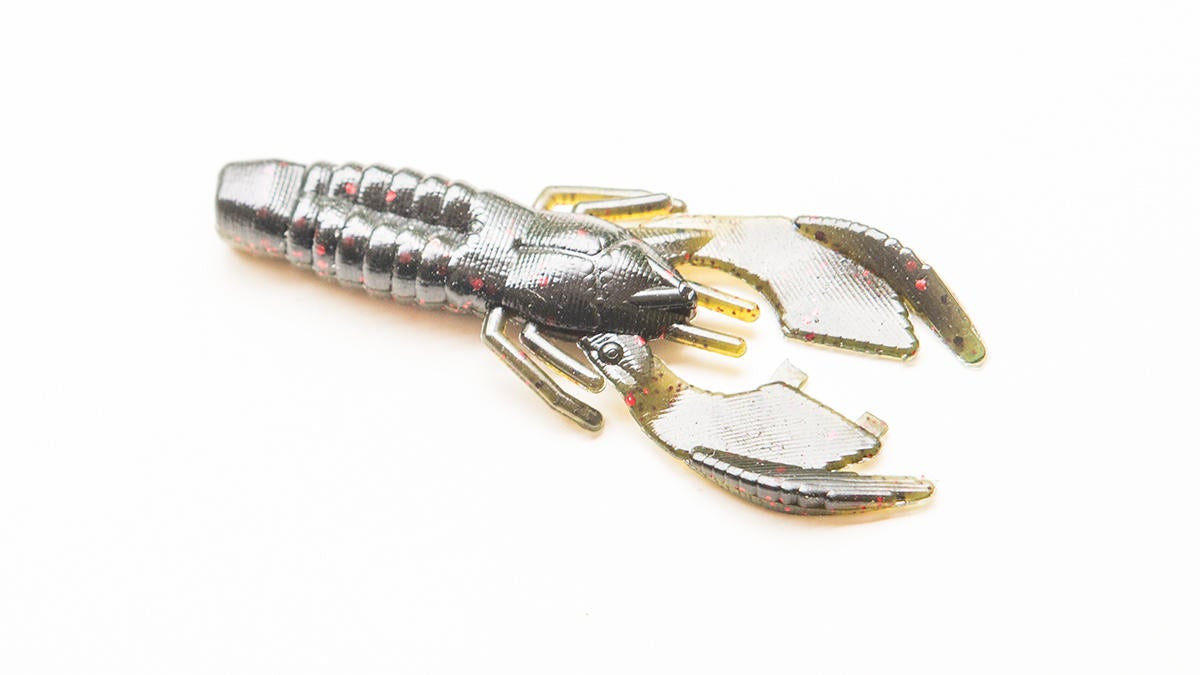
Bizz Baits Baby Bizz Bug
Since Chuck Woods of Kansas City, Missouri, created the Puddle Jumper in the early 1970s, and Dion and Guido Hibdon created the Guido Bug in the late 1970s, Midwest finesse anglers have been infatuated with and wedded to a variety of small crayfish-style and creature-style baits. And Bizz Baits’ Baby Bizz Bug became part of this world in 2018.
When we contacted Brian Souza of Huntersville, North Carolina, who is the proprietor of Bizz Baits, we apologetically told him that we were way overdue in publishing a gear guide about his Baby Bizz Bug. Despite our lack of assiduity, he forgave us by graciously sending us some to thoroughly examine.
Here is what we discovered about it.
According to one of Bizz Baits’ advertisements, it was designed with Midwest finesse anglers in mind, noting that it can be affixed to a mushroom-style jig. It was also noted that it can be used on a Texas rig and as a trailer on a skirted finesse-sized jig. Souza describes it as a blend of a crayfish-style and a beaver-style bait.
According to our measurements, it is 3 1/8 inches long.
It is an abstract rendition of a crayfish.
Its abdomen, which is situated on the posterior portion of a crayfish, is about 7/8-inch long. Its dorsal area is segmented with six tergums or segments, and these six tergums are indented with a hook slot that is about 3/4-inch long and about 1/8-inch wide at its widest spot. At its third tergum, it is 9/16-inch wide with a height of 5/16-inch and a circumference of about 1 5/8 inches. Its ventral area has seven segments, and they are indented with a hook slot.
The end of the Baby Bizz Bug’s posterior is not endowed with the uropods and telson of a crayfish. Instead, it is a solid piece of soft plastic with somewhat of a trapeze shape. It is about 3/8-inch long with a width of about 7/16-inch wide at its widest spot, a height of 5/16-inch and a circumference of about 1 1/4 inches. Its epidermis is smooth and its dorsal and ventral areas are identical.
The tip of this trapeze-shaped section is somewhat flat with a slight indentation, which is where Midwest finesse anglers will insert the hook and bait keeper of a mushroom-style jig. This tip has a width of five-sixteenths of an inch and a height of five-sixteenths of an inch.
The abdomen is attached to the Baby Bizz Bug’s cephalothorax. It is about three-quarters of an inch long. At its widest spot, it is about nine-sixteenths of an inch wide with a height of a 1/4 inch high and a circumference of about 1 1/2 inches. The dorsal area is endowed with a cephalic groove, rostrum, and carapace. Its ventral is smooth. Two walking legs radiate from each side of the cephalothorax. Each leg is jointed or bent. The first or front leg is 1/2-inch long and the second one is 11/16-inch long.
The Baby Bizz Bug has a cheliped or claw extending from each side of the cephalothorax. When the cheliped is fully extended, it is about 1 5/8 inches long. Along the outside edge of the claw, there is a significant ridge that is about one inch long, and at its highest spot, the ridge is 1/8-inch high. The rest of the claw is flat, and at the end of each claw, it is about 1/2-inch wide. It is also thin with a thickness of about 1/16-inch.
Two short antennules radiate off of the tip of the rostrum. They are cylinder-shaped with a diameter of slightly more than 1/16-inch. They are about 5/16-inch long.
When the Baby Bizz Bug is manufactured, the two claws are attached together. This makes it a bait with a beavertail. But the two attachments can be easily clipped, which allows the Baby Bizz Bug to have a pair of crayfish’s claws.
It is made with Bizz Baits’ signature buoyant plastic. But the Baby Bizz Bug does not float. Its claws, however, are relatively buoyant, which accentuates the claws’ ability to seductively undulate and gyrate.
It is available in the following hues: Alabama Craw, Bama Bug, BB Magic Craw, Black Blue, Black Blue Laminate, Bruised Olive, Cinnamon, Green Pumpkin, Green Pumpkin Blue, and Green Pumpkin Orange.
They are salt impregnated and scented with Bizz Baits’ signature Jack’em Juice.
You can find the Bizz Baits Baby Bizz Bug here.
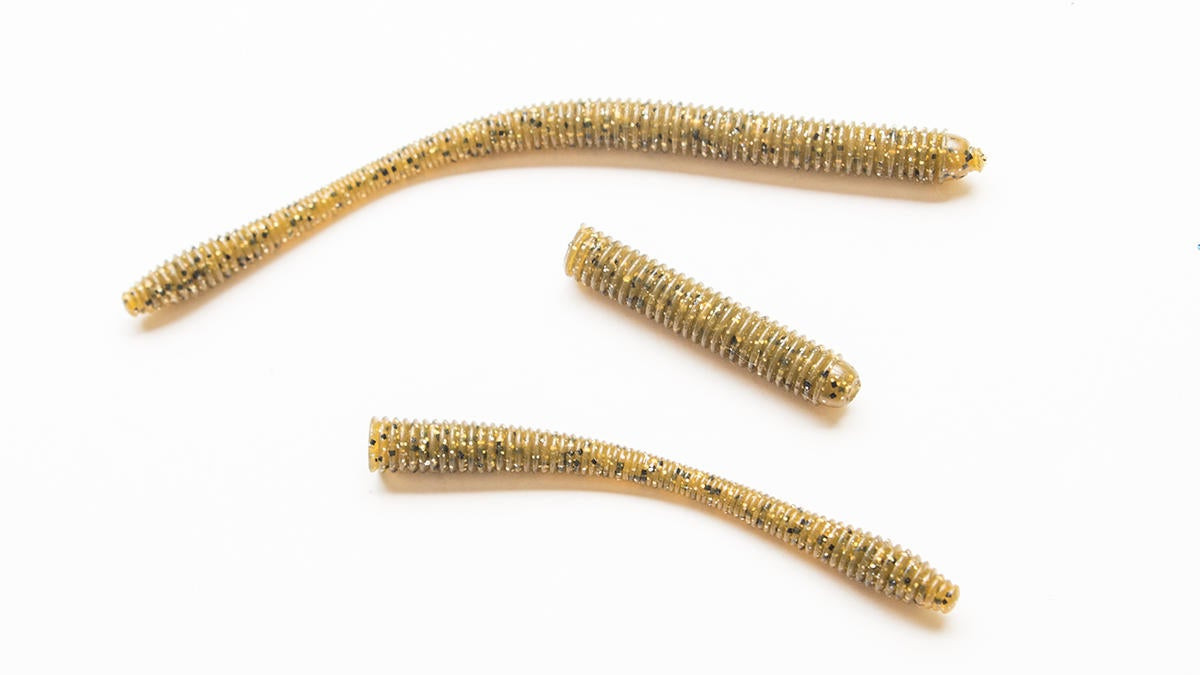
6th Sense Divine Shakey Worm
A shaky-style-jig-and-worm rig has been part of Midwest finesse anglers’ repertoire since the late and great Chuck Woods of Kansas City, Missouri, was building the foundations of Midwest finesse fishing in the 1950s and 1960s. In fact, Woods is credited for creating the angling world’s first shaky-head-jig-and-worm rig, and it was a Texas-rig jig with an aspirin-style head. And Dwight Keefer of Parsons, Kansas, used Woods’ jigworm rig to win the World Series of Sport Fishing at Long Lake, Wisconsin, in October of 1967, when Keefer was a sophomore at the University of Kansas. And Drew Reese of Rantoul, Kansas, used it when he competed in the first Bassmaster Classic at Lake Mead in 1971.
Thus, whenever veteran Midwest finesse anglers spot a new shaky-worm rig, usually one of them will contact us and suggest that we should publish a gear guide about it. And when one of them saw two YouTube videos about 6th Sense Fishing Products’ 6.3-inch Divine Shakey Worm, this angler alerted us.
Subsequently, we contacted Casey Sobczak of Willis, Texas, who is president of 6th Sense Fishing Products, and members of his staff. And they mailed us a package to work with and create a gear guide about it.
Here is what we discovered about it.
Our measurements revealed that it is 6 1/8 inches long.
It was not created for Midwest finesse anglers. Instead, it is a power angler’s rendition of a soft-plastic finesse worm and designed to be affixed to 6th Sense’s Divine Shakey Head jig, which sports hooks that range in size from 3/0 to 6/0 to 7/0. Therefore, as Midwest finesse anglers have done since the days of Chuck Woods in the 1950s and 1960s, they will customize the Divine Shakey Worm by shortening it, and of courses, they will affix it to a light-weight mushroom-style jig with an exposed hook.
The tip of the Divine Shakey Worm’s anterior section possesses a domed-shape head. At the head’s junction with the torso, it has a width of slightly less than 5/16-inch and a circumference of about one inch. Its epidermis is smooth. The top of the head has a small indentation, which is where Midwest finesse anglers will insert the mushroom-style jig’s hook and bait keeper.
Except for its head and tail, the anterior and posterior sections are encircled with scores of ribs or ridges, which are said to accentuate the torso’s ability to undulate and quiver alluringly. There are about 15 ribs per inch. And it is devoid of a clitellum, which many soft-plastic worms possess. From the tip of its head to the tip of its tail, the torso possesses a round shape.
The anterior section is 3 1/16 inches long.
At one inch from the top of its head, the torso has a width of slightly more than 3/8-inch and a circumference of about 1 1/4 inches. And at 2 1/2 inches from the top of its head, the width become slightly less than 3/8-inch and a circumference of about 1 3/16 inches.
At the junction of the anterior and posterior sections, the torso has a width of one-quarter of an inch and of one circumference of one inch.
The posterior section is 3 1/16 inches long.
At 4 3/16 inches from the tip of the head, the size of the posterior’s torso decreases to a width of 3/16-inch and a circumference of about 11/16-inch.
Along the final 1 11/16 inches of the posterior section, the size of the torso increases. And at a 1/2-inch from the tip of the posterior section, it has a width of about 3/8-inch and a circumference of about 1 3/16 inches.
The radical changes in the widths and circumferences of the posterior section helps to accentuate the gyrations of the torso.
The tip of the posterior section is graced with a miniscule dome or mushroom-styled tail. Its epidermis is smooth. It is about 3/16-inch wide with a circumference of about 3/4-inch.
It is available in the following hues: Black, Bluegill Fire, Bluegrass Magic, Cinnamon Crave, Cosmic Black, Darkmelon Red, Darkwater Bug, Gill Dust, Grass Candy, Green Pumpkin, Green Pumpkin Blue, Green Pumpkin Burst, Junebug Red, Melon Dawn, Melon Dust, Nirvana, Oxblood, Plum Fleck, Watermelon Candy, Watermelon Red, and Worm Juice.
It is not infused with scent. And even though it is impregnated with salt,
it is very buoyant, which will accentuate its ability to glide beguilingly when Midwest finesse anglers employ the swim-glide-and-shake retrieve.
Before Midwest finesse anglers affix the Divine Shakey Worm to a small mushroom-style jig, they will amputate about 2 1/16 inches from the front portions of the anterior section, making it 4 1/16 inches long. And some of them might use the 2 1/16-inch section of the anterior section as a short stick-style bait.
6th Sense also makes a 7.0-inch Divine Shakey Worm, which Midwest finesse anglers could customize into a 4-inch worm and a 3-inch stick-style bait.
You can find them at these retailers:
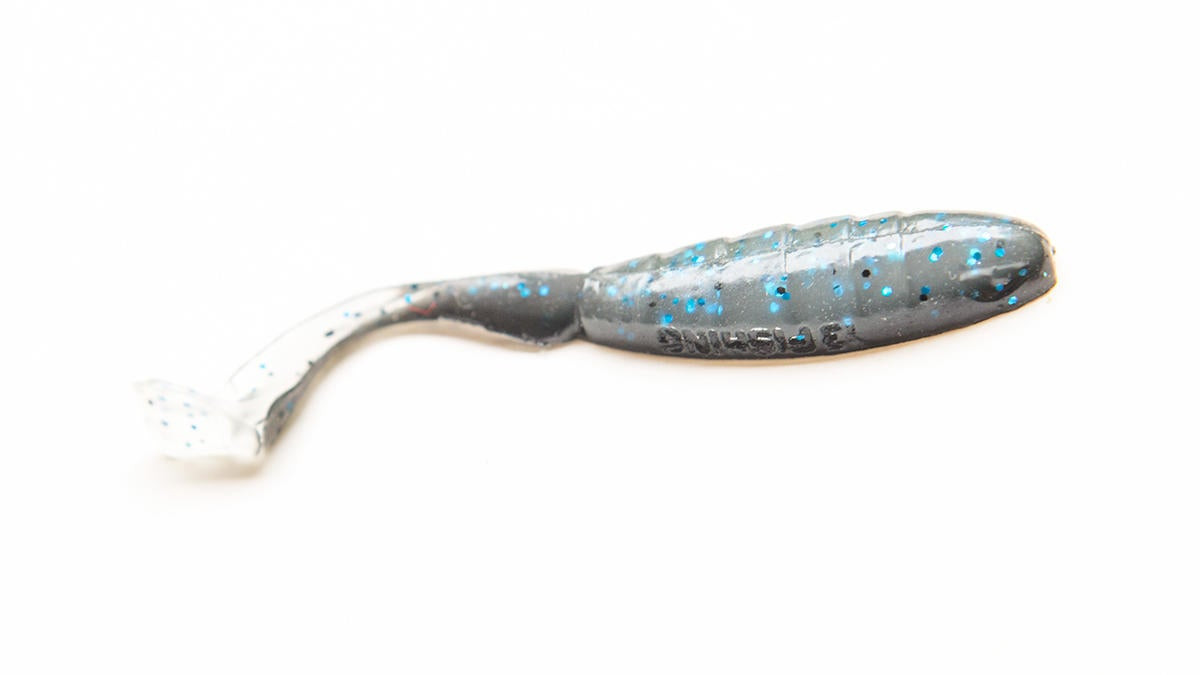
13 Fishing Vertigo Minnow
At the 2019 International Convention of Allied Sportfishing Trades show, 13 Fishing introduced its 3- and 4-inch Vertigo Minnow to the angling world.
One of the 2019 ICAST’s YouTube videos features Brandon Coulter’s insights about the Vertigo Minnow. He resides in Knoxville, Tennessee, and has competed on the Bass Pro Tour, Bassmaster Elite Series, FLW Tour, and Major League Fishing circuits since 2006. Coulter described it as a state-of-the-art soft-plastic minnow that was designed to be affixed to a drop-shot rig, and he was eager to use it to inveigle scores and scores of smallmouth bass that abide in the Great Lakes and other northern waterways.
Since that introduction, it has caught the eyes of several Midwest finesse anglers who encouraged us to publish a gear guide about it. Of course, these anglers would rig it on a small mushroom-style jig with an exposed hook. The reason why they prefer rigging it on a mushroom-style jig stems from the fact that a drop-shot rig isn’t as effective for inveigling largemouth bass and smallmouth bass in the waterways that these anglers normally fish.
At one of these anglers’ constant behest, we eventually contacted Reid Miller of Clearwater, Florida, who is the marketing coordinator for 13 Fishing, and told him we would like to publish a gear guide about it. He graciously responded by sending us several samples.
Here is what we discovered about the 3-inch Vertigo Minnow.
It is 3 1/8 inches long and exhibits a very abstract rendition of a minnow.
Its anterior section is 1 9/16 inches long and possesses an elliptical shape.
Its dorsal area is convex.
From the tip of its head or predorsal area to the junction with it posterior section, the middle or center of the dorsal area is embossed with a tiny groove.
Its predorsal area is about 7/16-inch long. It is about 1/2-inch wide at its widest spot with a circumference of about 1 1/4 inches and a height of about 1/4-inch. It is adorned with two eyes, which have a diameter of about a 1/4-inch. Except for those eyes, the predorsal’s epidermis is smooth.
The final 1 1/8 inches of the anterior section is endowed with five segments that are demarcated with six groves. At its widest spot, it is 1/2-inch wide with a circumference of about 1 3/8 inches and a height of about 5/16-inch. One side of this section is inscribed with “13 Fishing,” and this inscription is 5/8-inch long with a height of about 1/8-inch.
The anterior’s entire ventral region is flat with a smooth epidermis.
The junction of the anterior and posterior sections is quite dramatic. It is delineated by two V-shaped indentations on each side of this junction. And the width of this junction is about 3/16-inch.
The posterior section is 1 9/16 inches long.
The first 9/16-inch of the posterior has somewhat of a tear-drop shape. At its widest spot, it is 3/8-inch wide with a circumference of 13/16-inch. Its dorsal is convex with somewhat of a triangular shape and its epidermis is smooth. The ventral area is flat with a smooth epidermis.
The final inch of the posterior section becomes narrow and thin. It is tipped with what anglers call a boot-style tail. At its narrowest spot, this portion of the posterior has a width of about 1/16-inch. Near the posterior section’s junction with its boot tail, its width increases to about 1/8-inch. The ventral area is flat with a smooth epidermis. The dorsal has a very narrow ridge, which has a height that ranges from about 1/6-inch to about 3/16-inch at its junction with its boot tail.
The boot tail is 9/16-inch long with a width of 3/8-inch at its widest spot.
It is available in the following hues: Buttercup, Cinnamon Toast, Glitter Bomb, Magic Dragon, Melancholy, Mojito, Mudskipper, OG Sour, Purple Rain, Whitey Tighties, and Young Padawan.
It is buoyant and infused with 13 Fishing’s Donkey Sauce Bite. And it is manufactured with what 13 Fishing describes as a “precision hand-pour” technique.”
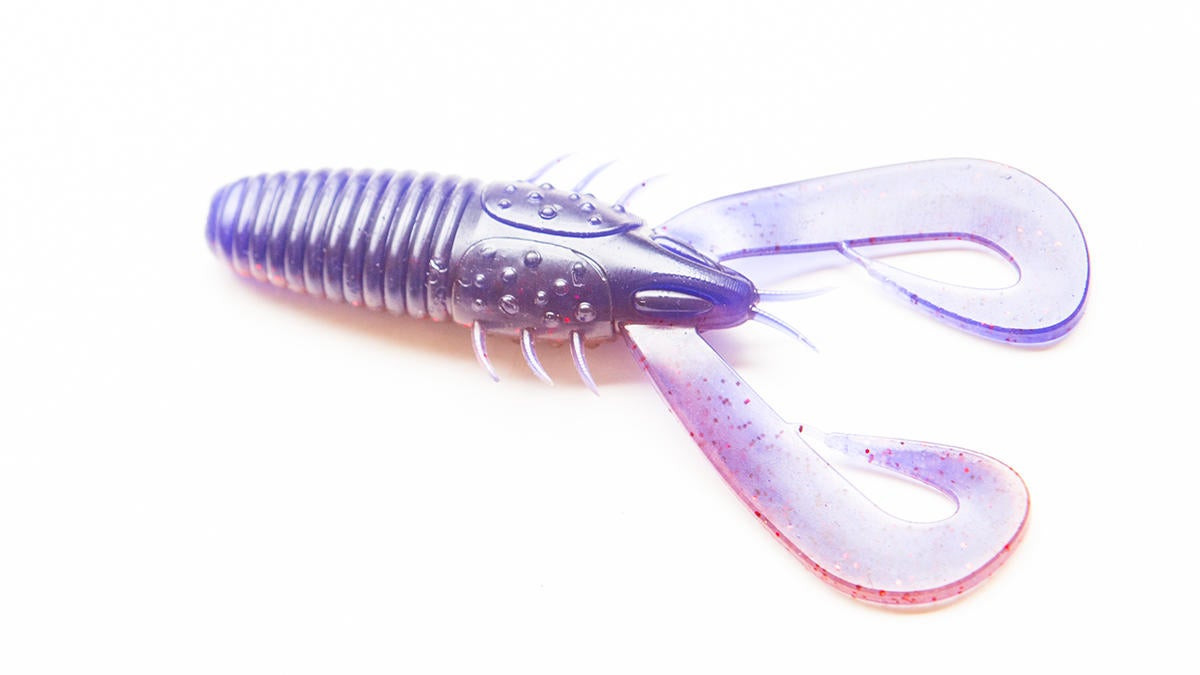
6th Sense Stroker Craw
The designers at 6th Sense Fishing Products did not create the Stroker Craw for Midwest finesse applications. But there is a school of Midwest finesse anglers who are incessantly in search for crayfish-style baits to affix to a 3/32-ounce mushroom-style jig. Some of these are old-timers stretch back to the days of the original Guido Bug in the late 1970s and early 1980s.
At the behest of one of these old-timers, we exchanged emails with Zach Kinart of Conroe, Texas, who is the national sales manager at 6th Sense Fishing, and he sent us a package of the Stroker Craw for us to work with, thoroughly examine, and publish a gear guide about it.
Here is what we discovered about the Stroker Craw.
It is 3 9/16 inches long.
Its abdomen is 1 1/8 inches long. It is oval-shaped and encircled with 12 ribs. The tip of the abdomen is slightly indented, and it is where a Midwest finesse angler will insert the hook and bait keeper of a mushroom-style jig. This tip has a width of about 5/16-inch, a height of about 3/16-inch and a circumference of about 1 3/16 inches. At the junction of the Stroker Craw’s abdomen and its cephalothorax, it has a width of 11/16-inch with a circumference of 1 11/16 inches. At a 1/2-inch from the abdomen’s tip, the width is about 5/8-inch and a circumference of about 1 3/4 inches. The dorsal and ventral areas are identical.
The Stroker Craw’s cephalothorax, which includes its head, is slightly more than 1 1/8 inches long. The dorsal and ventral areas are identical and they are endowed with an abstract replica of a crayfish’s carapace, cephalic groove, eyes and rostrum. Three tiny walking legs, which are about 3/8-inch long, radiate off of each side of the cephalothorax and they subtly quiver. Between walking legs numbers two and three, the cephalothorax is 3/16-inch wide with a circumference of 1 7/8 inches and this is the bulkiest portion of the Stroker Craw’s body.
The Stroker Craw’s two chelipeds, which are its claws, are flat and thin. One extends from each side of the cephalothorax. At the cheliped’s junction with the cephalothorax, the cheliped has a width of about 1/4-inch, and at 1 1/8 inches from that junction, the width of the cheliped is about 3/8-inch. The cheliped’s outside edge possesses a thickness that ranges from slightly more than 1/16-inch to slightly less than 1/16-inch and its inside edge is a touch thinner than the outside edge. It is J-shaped, possessing a profile that is similar to the tail of a curly-tailed grub. At rest, it is about 1 1/2 inches long and when it is fully stretched out, it is 2 13/16 inches long.
There are two antennules that are attached to the tip of the head, and they are 3/8-inch long and readily quiver.
It is manufactured in the following hues: Black N Blue Flake, Bluegrass Magic, Darkmelon Red, Gill Dust, Grass Candy, Green Pumpkin, Green Pumpkin Blue, Green Pumpkin Burst, Junebug Red, Oxblood, Platinum White, Watermelon Red, and Worm Juice.
It is impregnated with salt and it is not buoyant.
You can find the 6th Sense Stroker Craw here.
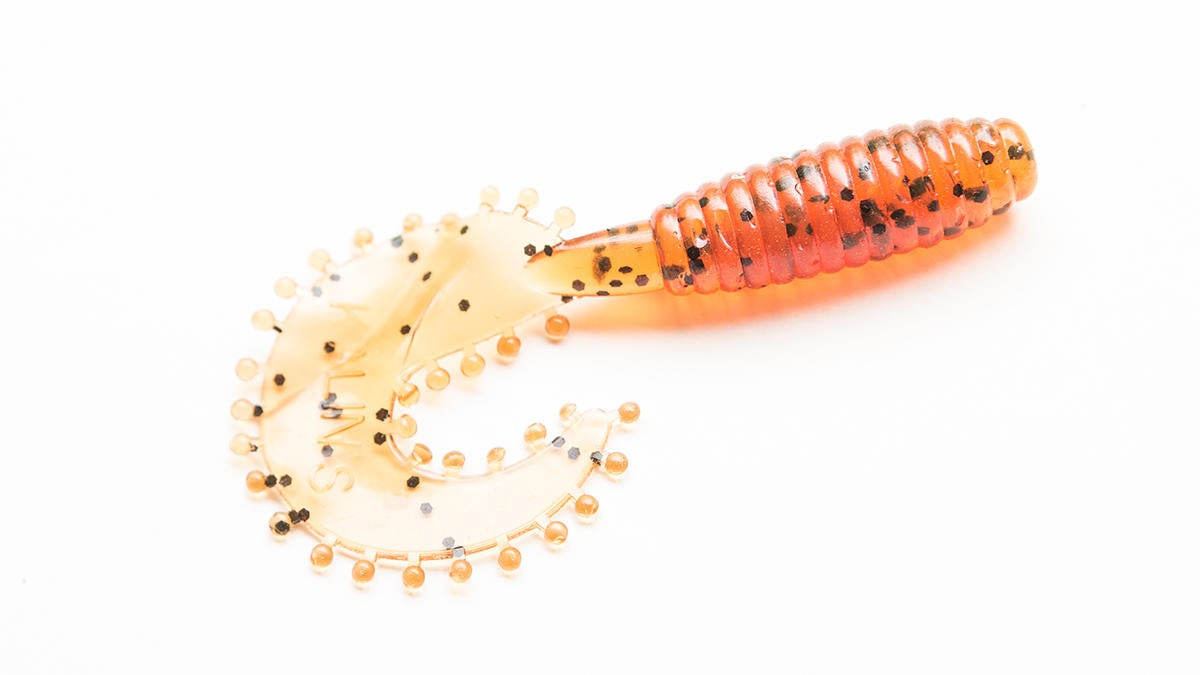
Kalin’s Tickle Grub
During the 1980s, a goodly number of the pioneers of Midwest finesse fishing became infatuated with the Lunker Grub, which was the creation of the late and great Al Kalin of Brawley, California.
Kalin died on April 20, but the company that bears his name is still manufacturing soft-plastic baits that cater to the tactics that Midwest finesse anglers employ.
In 2007, Kalin sold his company to Acme Tackle Company of Fort Atkinson, Wisconsin, and in 2019, they created the 3- and 5-inch Tickle Grub.
We exchanged emails and a few telephone conversations with Matt Bichanich, who is the vice president of sales for Acme Tackle, about the Tickle Grub. And he provided us with some samples of them for us to work with and thoroughly examine in order to publish a gear guide about them.
We opted to focus on the 3-inch model, and here is what we discovered about it.
When its tail is curled or at rest, it is 2 11/16 inches long. When the tail is extended, it is 3 11/16 inches long.
Its head is round and slightly more than 1/16-inch long. It has a diameter of a 1/4-inch and a circumference of 7/8-inch. Its tip is flat with a slight indentation, which is where a Midwest finesse angler will insert the hook and bait keeper of a jig.
The entire torso, including the head, is 1 5/8 inches long.
The first 1 3/16 inches of the torso is encompassed with 13 ribs. At ribs numbers six and seven, the width of the torso is 3/8-inch with a circumference of 1 1/4 inches. At rib number 13, it is 5/16-inch wide with a circumference of 1 1/8 inches.
The final 7/16-inch of its torso is devoid of ribs and its epidermis is smooth. And the last 3/16-inch of this part of the torso melds into the grub’s tail. The tip of this segment is somewhat bullet shaped. Adjacent to rib number 13, this portion of the torso has a width of 1/4-inch and a circumference of 3/4-inch. At its junction with its tail, the torso has a width of 3/16-inch and a circumference of 11/16-inch.
Its radically curled tail is thin and flat, exhibiting a thinness of less than 1/16-inch.
Near its junction with the torso, the tail is about 3/8-inch wide. At its widest spot, which is 5/8-inch from its junction with the torso, it is 1/2-inch wide. The width decreases to 3/16-inch at 3/16-inch from the tip of the tail.
The outside edge of the tail is about 3 3/4 inches long and its inside edge is about 1 9/16 inches long.
The outside edge of the tail is adorned with 23 short appendages, and each appendage sports a tiny ball. The tail’s inside edge is adorned with 11 short appendages and balls. These appendages are less than 1/6-inch long. Each ball has a diameter of about 1/16-inch. These 34 appendages are designed to displace water, which will create more vibration than the original Kalin curly-tailed grub.
It is available in the following hues: Blue Pearl Salt & Pepper, Chartreuse Hologram, Chartreuse Pearl, Chartreuse Salt & Pepper, Pumpkin Salt & Pepper, Smoke Salt & Pepper, White, and White Ice.
It is not impregnated with salt nor scent. It is buoyant, which is an asset in the eyes of Midwest finesse anglers.
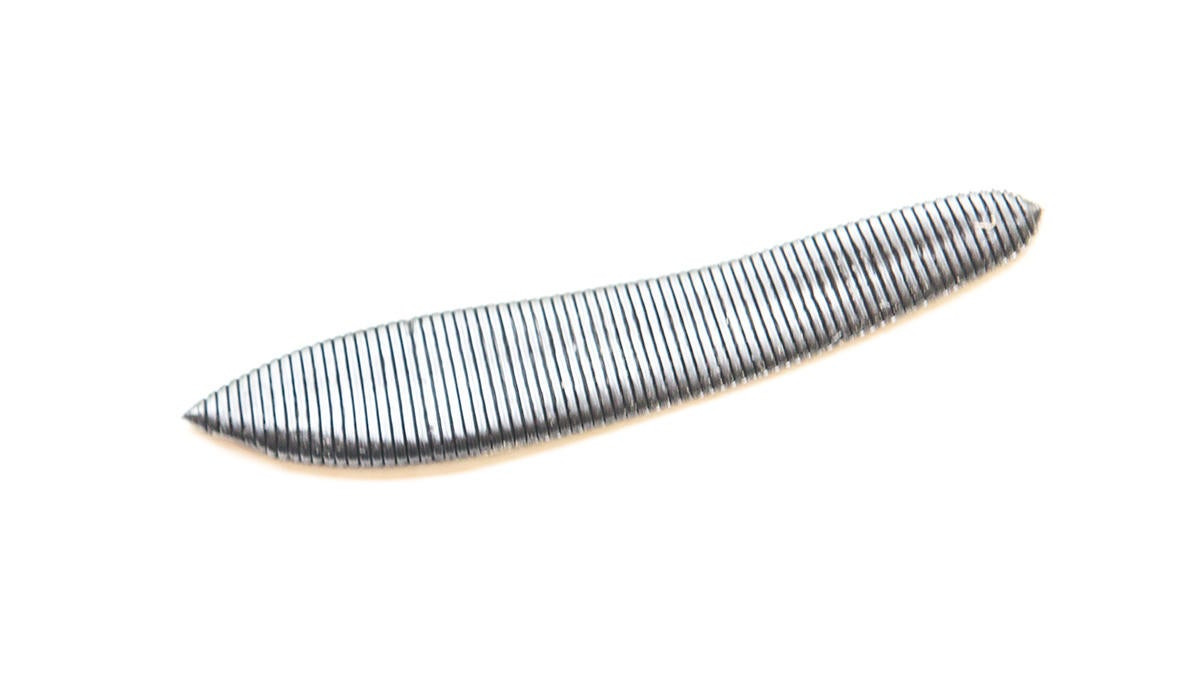
Lunkerhunt Leech
Lunkerhunt of Toronto, Ontario, has created a 3-inch and 5-inch soft-plastic leech in 2017 that recently caught the eyes of a veteran Midwest finesse angler who thought that we should publish a gear guide it.
It is aptly called the Leech, and Ronan Duckenfield sent us a sample of them to work with and thoroughly describe.
Here is what is we discovered about them.
According to our measurements, the 3-inch Leech s exactly 3 inches long.
From the tip of its anterior section to the end of its posterior section, its entire torso is extremely thin. Our measurement notes that its anterior is slightly more than 1/16-inch thick. And the thickness of the posterior section is slightly less than 1/16-inch.
Its anterior section is wider than its posterior section. Its widest spot is situated about 13/16-inch from the tip of the anterior section, and at this spot, its torso has a width of 9/16-inch.
At the junction of the anterior and posterior sections, its torso has a width of about 1/2-inch.
At 3/4-inch from the end of its posterior section, it has a width of 3/8-inch.
The tip of the anterior section has the shape of an arrowhead. It is likely that most anglers will describe this tip as the Leech’s head.
The end of the posterior section has a blunter-shaped arrowhead and most anglers will describe this tip as the Leech’s tail.
The folks at Lunkerhunt describe the Leech as possessing “an anatomically correct design.”
The epidermis of its entire dorsal area is lined with scores of minute ribs.
The epidermis of its ventral area is possessed with scores of minute ribs, too. But within the first 11/16-inch of the tip of the anterior section, it is embellished with an oval-shaped feature that has a smooth epidermis. It is 9/16-inch long and about 5/16-inch wide at its widest spot.
Likewise, the epidermis of the last 11/16-inch of the end of the posterior section has a pointed-oval shaped feature that has a smooth epidermis. It is about 5/8-inch long and about 3/16-inch wide at its widest spot.
Both of these small oval-shaped features increase the thickness of the torso about a centimeter.
According to our measurements, the 5-inch Leech is 4 1/4 inches long.
It possesses many of the same physical characteristics as the 3-inch Leech.
From the tip of its anterior section to the end of its posterior section, its entire torso is thin. Our measurement notes that its anterior is slightly more than 1/16-inch thick. And the thickness of the posterior section is about 1/16-inch.
Its anterior section is wider than its posterior section. Its widest spot is situated at 1 1/4 inches from the tip of the anterior section, and at this spot, its torso has a width of 3/4-inch.
At the junction of the anterior and posterior sections, its torso has a width of 5/8-inch.
At 3/4-inch from the end of its posterior section, it has a width of nearly a 1/2-inch.
The tip or head of the anterior section has the shape of an arrowhead.
The end of the posterior section is blunt, possessing the motif of a flat-head screwdriver.
The epidermis of its entire dorsal area is lined with scores of minute ribs.
The epidermis of its ventral area is lined with minute ribs, too. But within the first 3/4-inch of the tip of the anterior section, it is adorned with an oval-shaped feature that has a smooth and almost glassy epidermis. This feature is 9/16-inch long and 5/16-inch wide. And the epidermis of the last 3/8-inch of the end of the posterior section has a lanceolate-shaped feature that has a smooth epidermis. Both of these small features increase the thickness of the torso about a centimeter.
The Leech is available in the following hues: Black, Meatlocker, Sandy, and Watermelon. The Meatlocker hue looks similar to the traditional green-pumpkin-goby hue.
It is impregnated with fish protein.
They are buoyant and durable. Lunkerhunt describes them as being neutrally buoyant, which allows them to exhibit “a natural action at all times.”
Midwest finesse anglers will affix the Leech to a jig either near the tip of the anterior section or near the end of the posterior section. The hook of the jig will be inserted into the Leech’s torso at the smooth oval or lanceolate features on each of the ends of the ventral area.
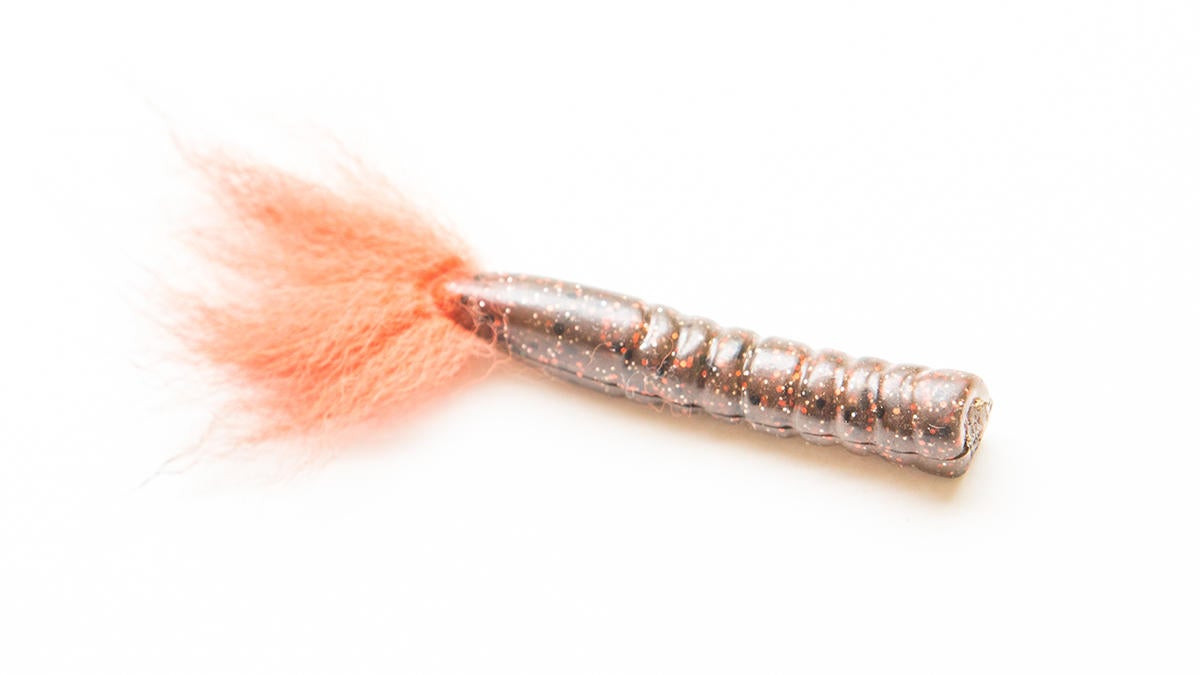
Rabid Baits Fox Tail
In 2016, Rabid Baits of Poultney, Vermont, slowly and meticulously began to design and create prototypes of several unique finesse baits. By 2019, they had created four soft-plastic finesse baits that were adorned with pieces of rabbit zonker.
These four baits are called the Darter, Goby, Rabid Craw, and Shaker Worm.
Rabid Baits most recent creation is called the Fox Tail, and they mailed us some samples of it to work with, thoroughly examine and eventually publish a gear guide about it.
Here is what we discovered about the Fox Tail.
It is a novel stick-style bait. In fact, it is so novel that some of its facets are difficult to describe.
For example, in some Midwest finesse anglers’ eyes, it abstractly represents the features of a small fish. While in the eyes of some other Midwest finesse anglers, it abstractly represents the features of a crayfish, and these anglers contend that the strands of rabbit fur are imaginary claws or chelae of a crayfish. From the perspectives of others, these multi-faced features will accentuate its versatility and effectiveness.
The samples exhibit slight variations in their lengths. For example, the lengths of their soft-plastic torsos range from 1 15/16 inches to 2 inches. The lengths of the rabbit fur that radiate from the two sides of the tip of its torso fluctuate from being 2 1/4 inches to 2 9/16 inches long.
Its soft-plastic torso possesses a cylindrical shape. And its sides, dorsal and ventral areas are identical.
The portion of the torso that dons the rabbit zonker possesses the shape of the head of either a logperch or a slenderhead darter. But one Midwest finesse angler described the shape as being similar to the head of a snake that is adorned with “a heck of a beard.” This section ranges in length from 3/4- to 13/16-inch long. At its widest spot, it is about 7/16-inch wide and a circumference of about 1 1/4 inches. The width and circumference of this section diminish as it approaches the area where the rabbit fur is attached, where it has a width of about 1/8-inch and a circumference of about 11/16- inch. The epidermis of this section of its soft-plastic torso is smooth.
The next 1 1/4 inches of its soft-plastic torso is cylindrical-shaped and segmented.
The tip of this section of the torso is flat with a diameter of 7/16-inch and a circumference of about 1 1/4 inches and this is where Midwest finesse anglers will insert the hook and bait keeper of their mushroom-style jigs.
Between this tip of the torso and the section that resembles the shape of the head of either a logperch or a slenderhead darter, there are seven segments or ribs. The middle or fourth segment, which is 5/8-inch from the flat tip, has a length of 3/16-inch, a width of 5/16-inch and a circumference of about 1 1/16 inches. The other six segments are about 1/8-inch long. The first segment, which is adjacent to the flat tip of the torso, has a circumference of about 1 1/4 inches and a width of about 3/8-inch. The seventh segment has a width of about 3/8-inch with a circumference of about 1 1/4 inches.
Midwest finesse anglers are inveterate customizers of soft-plastic baits, and many of them will shorten it by trimming a segment or two from the tip of the torso.
It is available in the following hues: Erie, Green Pumpkin Black, Green Pumpkin Chartreuse, Green Pumpkin Orange, June Bug, Midnight Magic, Monster Red Ruby, Mud Puppy, and St. Lawrence.
It is neutrally buoyant.
Bob Scott Sr., Bob Scott Jr, and Joshua Mossey, who are co-owners of Rabid Baits, told us that the prototypes of their Fox Tail exhibited a flair for inveigling a variety of fish when it was field-tested. In various freshwater applications, it caught crappie, lake trout, largemouth bass, smallmouth bass, walleye, and several other species. And Mossey used it in saltwater to catch redfish and speckled trout.
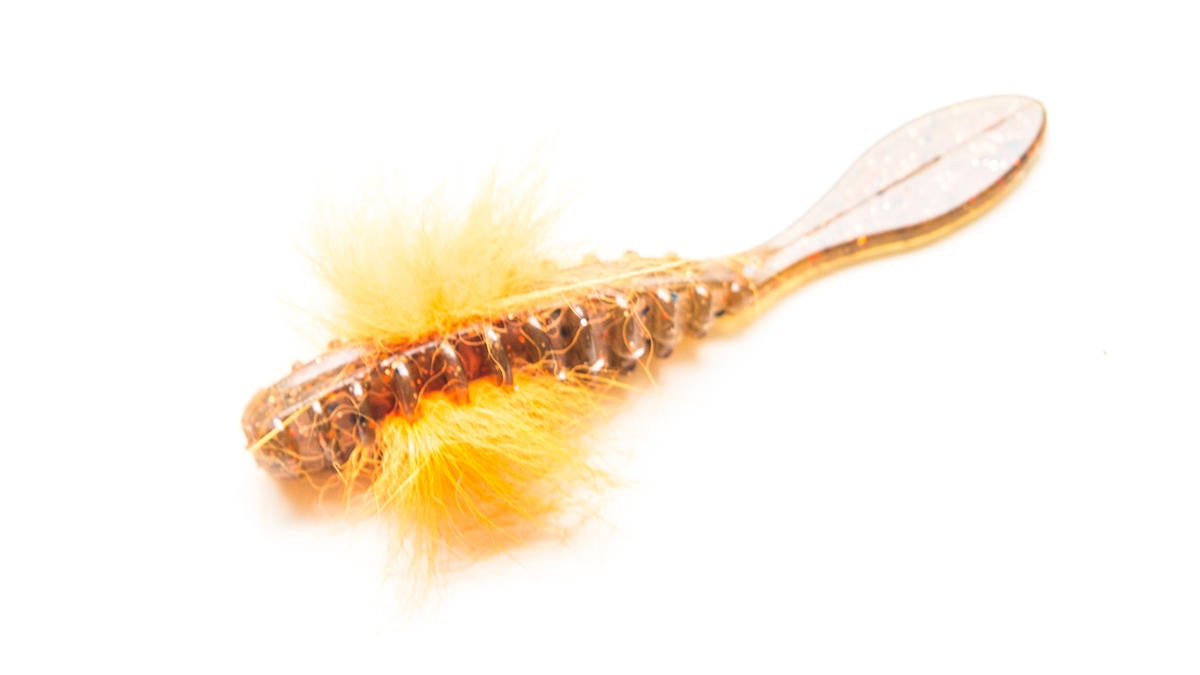
Rabid Baits Darter
Rabid Baits of Poultney, Vermont, manufactures four unique soft-plastic finesse baits that are adorned with rabbit zonkers.
They are the Darter, Goby, Rapid Craw, and Shaker Worm.
This detailed gear guide focuses upon their Darter.
It is 3 1/8 inches long, which is an ideal size in the eyes of scores of Midwest finesse anglers.
There are about 30 species of Percina darters, and 13 of them can be found in Midwestern waterways. The other 17 abide in eastern Canada and United States. There are about 90 species of Etheostoma darters in North America and about 30 of them can be found in waterways in the central portions of the U.S. The majority of darters are bottom-oriented creatures, but there are some that abide above the bottom and around patches of submerged aquatic vegetation.
Rabid Baits’ Darter is an extremely abstract rendition of these 120 darter species.
The snout of its head is somewhat shaped like a pig’s nose, which is a characteristic of several of the Percina darters. It possesses a significant indentation with a width of 1/4-inch, a height of 1/4-inch and a circumference of 1 1/4 inches.
Each side of the first 1 13/16 inches of its torso is embellished with 10 significant ribs or segments. The distance between each rib is about 1/8-inch.
Its dorsal area of this portion of the Darter’s torso is significantly indented. This indentation is 1 1/2 inches long. The middle portions of this indentation are more substantial than they are around its anterior and posterior areas. At 3/4-inch from the tip of its nose and situated between ribs number five and six, the dorsal’s indentation is endowed with a delicate assemblage of rabbit fur, which creates a unique dorsal fin. The fur extends about 1 1/4 inches above the dorsal area.
On each side of the torso and at rib number four, it is graced with a cluster of rabbit fur, creating a pectoral fin. Each fin is about one inch long.
The ventral area is endowed with the same indentation as its dorsal possesses, but it is devoid of a rabbit-fur fin.
At rib number one, the torso’s width is 7/16-inch with a height of 3/8-inch and a circumference of 1 3/8 inches.
At ribs number five and six, the circumference is 1 5/8 inches with a width of about 1/2-inch and a height of 3/8-inch.
At rib number 10, the width is 5/16-inch with a height of about 3/16-inch and a circumference of about 1 1/16 inches.
The configuration of the final 1 7/16 inches of the Darter becomes flat and thin. Its epidermis is smooth. At the junction of this section to the ribbed section, its flat dorsal and ventral areas are about 5/16-inch wide and each side is about 1/8-inch high. At 1/4-inch from that junction, the width slims down to 3/16-inch. An anatomist might describe this area of the Darter as its caudal-peduncle section, which is the smallest portion of a fish’s torso, and it also possesses the junction with a fish’s tail fin, which an anatomist calls the caudal fin.
The Darter’s caudal fin is paddle-shaped, and it is about 1 1/16 inches long with a width of about 1/2-inch at its widest spot, which is situated at 7/16-inch from the tip of the tail.
They are manufactured in the following colors: Chartreuse, Erie, Ghost, Green Pumpkin Orange, Mud Puppy, and St. Lawrence.
Some Darters are buoyant, and some are neutrally buoyant.
The three rabbit-fur fins are hand-tied and securely embedded and anchored inside the Darter’s torso.
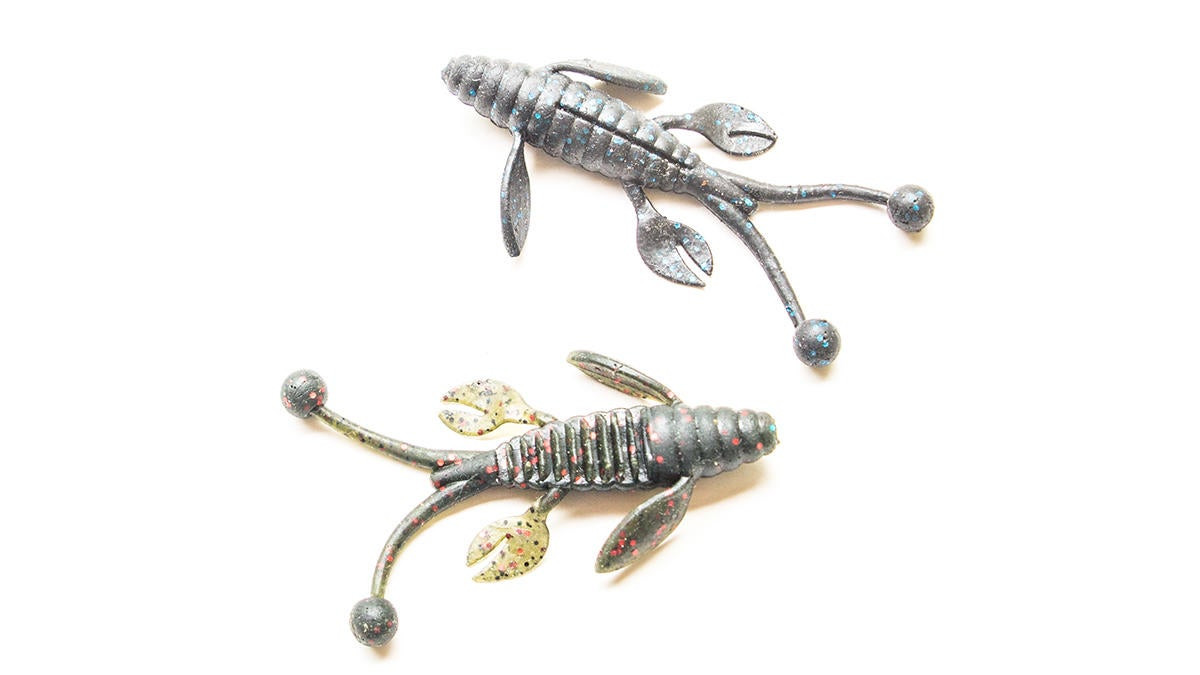
Molix Freaky Flex
In the eyes of several veteran Midwest Finesse anglers, Molix’s Freaky Flex is a state-of-the-art Puddle Jumper.
The Puddle Jumper was the creation of yhr late and great Chuck Woods of Kansas City, Missouri. And in the early 1970s, it was our first soft-plastic and finesse-size creature-style bait, which we used to catch untold numbers of black bass, crappie, and white bass.
When Molix introduced their 21st-century finesse-size creature-style bait, it immediately caught the attention of several of the old-time aficionados of the Puddle Jumper, and they provoked us to correspond with Paolo Vannin of the Molix USA Corporation of Sewell, New Jersey, in hopes that we would publish a gear guide about the Freaky Flex.
To our delight, Vannin provided us with some details about it and a few samples to work with.
Here is what we discovered about the Stick Flex.
Molix is an Italian company that is headquartered in Molinella, Bologna, Italy.
Their Freaky Flex is manufactured with a material that is called MOLIX FORMULA, which is an extremely buoyant, flexible, and durable soft-plastic compound. It is durable enough to endure numerous donnybrooks with largemouth bass, smallmouth bass, and spotted bass.
It possesses some of the features of a fish, crayfish and an array of aquatic invertebrates.
According to our measurements, it is 2 15/16 inches long.
Its posterior section is 1 5/8 inches long. Its anterior is 1 7/16 inches long.
At its widest spot, its posterior has a width of about 3/16-inch.
The dorsal portion of its posterior is embellished with 14 ribs or segments. It is also endowed with a hook slot that is 7/8-inch long, and this slot stretches from rib number seven to rib number 14. The dorsal is convex.
The fourth rib from the end or the anus of the posterior has a width of about 5/8-inch and a circumference of about 1 1/4 inches.
There is an appendage radiating from each side of the fifth rib. These appendages have an elliptical shape. They are thin and flat with a length of 3/4-inch, a width of 5/16-inch at their widest spot and a thickness of about 1/16-inch. They are somewhat similar to the pelvic fins of a greenthroat darter and slenderhead darter.
At the seventh rib, its posterior has a width of about 7/16-inch and a circumference of about 1 1/2 inches.
An appendage extends from each side of the eleventh rib. They are an abstract rendition of a crayfish’s claw or cheliped. They are flat and thin with a length of 3/4-inch and a width of 5/16-inch at their widest spot. They are less than 1/16-inch thick.
At the fourteenth rib, the torso has a width of about 1/4-inch and a circumference of about 3/4-inch. This rib is situated at the junction of the torso and the Freaky Flex’s head.
The posterior section’s ventral area is embellished with six convex ribs, which are identical to its dorsal’s ribs. They encompass 3/4-inch of the ventral area and they are adjacent to its anus.
The ventral’s next 7/8-inch is adorned with a feature that Molix calls micro-flaps and there are nine flaps. These flaps are thin with a height of slightly less than 1/8-inch. The gap or distance between each flap is about 1/16-inch. The first one has a width of 7/16-inch and the ninth flap, which is adjacent to the junction with the Freaky Flex’s tail, has a width of about 3/16-inch. This micro-flap portion of the ventral is flat rather than convex.
The anterior section consists of a small head and an antenna radiates off each side of its head.
The head is about 7/16-inch long and 3/16-inch wide at its junction with its posterior section. The tip of the head has a width of about 1/8-inch.
Each antenna is about 1 1/16 inches long. They are crowned with a significant ball-like object, which has a diameter of about 1/4-inch and a circumference of 7/8-inch. Near the antenna’s junction with the head, it has a width of about 1/8-inch and near the junction with the ball, the antenna’s width is about 1/16-inch.
They are available in the following hues: Alewife Laminate, Black Blue Flake, Chartreuse, Cola, Gold Ayu, Green Pumpkin, Orange Pumpkin, Wakasagi, Watermelon Gold Chartreuse, Watermelon Red Black Flake, Watermelon Silver Shad, and White Shad.
They are impregnated with salt and a shrimp scent.
You can find the Molix Freaky Flex here.
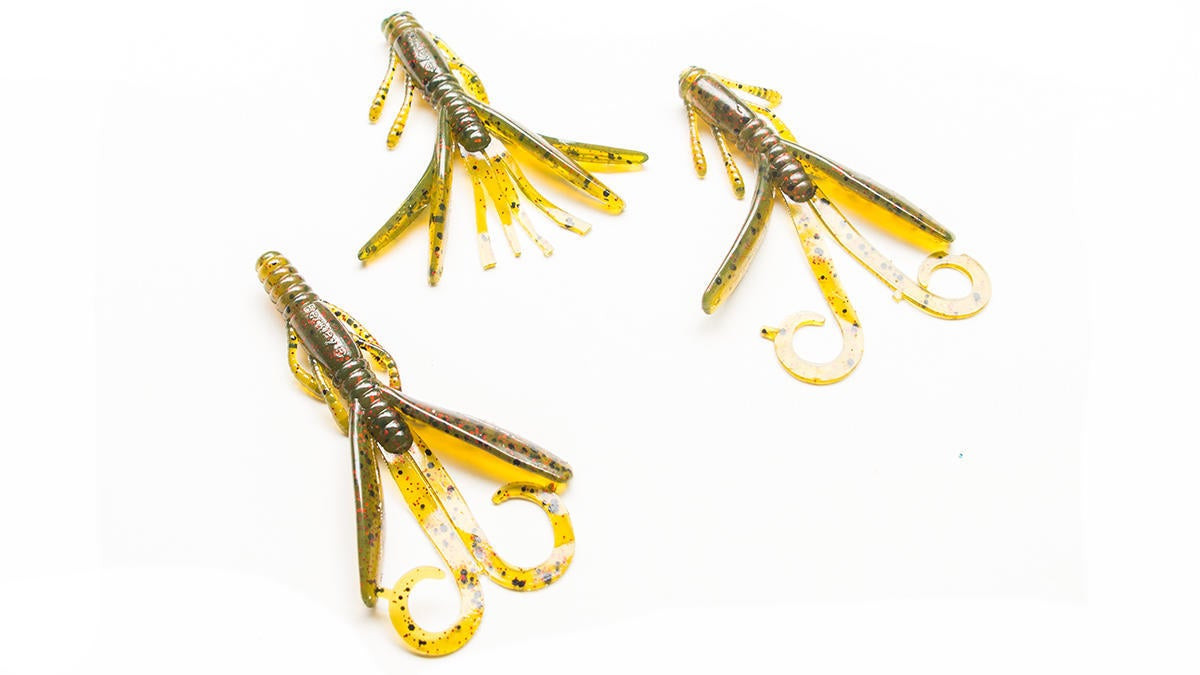
Berkley PowerBait Power Hawg
Berkley reintroduced its PowerBait Power Hawg to the angling world at the 2018 International Convention of Allied Sportfishing Trades show in Orlando, Florida.
This creature bait has been a standard tool for a number of the anglers in the power-fishing fraternity for many years. For instance, Skeet Reese of Auburn, Calif., has lauded and wielded it often. In fact, it played a significant role in his win at the Bassmaster Elite tournament at the Potomac River in August of 2007.
Even though it is a power bait, it has recently caught the eye of some Midwest finesse anglers who are inveterate customizers of power baits. And one of them suggested that we should publish a gear guide about the smallest version of the Power Hawg.
We asked Hunter Cole of Columbia, South Carolina, who is Berkley’s media and public relations manager, to help us in our endeavor. He responded by sending us some samples to examine and describe.
The small one is advertised as being four inches long. Our measurements, however, reveal that it is 5 3/4 inches long when its two curly appendages are fully extended and it is 4 1/4 inches long when these appendages are not fully extended.
Its torso is 2 5/16 inches long and divided into three sections: anterior, clitellum, and posterior, which are features of the anatomy of an earthworm.
Its posterior section is 3/4-inch long. It is encircled with five segments and tipped with an anus. At its widest spot, it is 3/8-inch wide with a circumference of about 1 1/4 inches.
Its anus is slightly indented, which is where the hook and collar of a Midwest finesse angler’s mushroom-style jig will be affixed. The tissue surrounding this indention is a 1/4-inch wide with a circumference of about 1 1/16 inches.
Its clitellum is 3/4-inch long. It is 5/16-inch wide with a circumference of about 1 7/16 inches. Except for the word Berkley, which is 5/8-inch long and an eighth of an inch wide, the clitellum’s epidermis is smooth.
At the junction of the posterior and clitellum sections, a small appendage extends from each side of the torso. These appendages are 11/16-inch long and they are graced with a series of minute segments. The circumference at the tip of each appendage is 3/8-inch and the circumference is much smaller were the appendages join the torso. A 1/4-inch above the back two appendages, there are two more small appendages that radiate from each side of the clitellum. The four appendages that don the sides of the clitellum are identical in size and configuration.
The anterior section is 7/8-inch long. It is encircled with seven segments. It is 1/4-inch wide with a circumference of about 1 1/16 inches.
The anterior is adorned with two large and flat appendages. They radiate from each side of segments number four and five. These appendages are 1 1/16 inches long, 7/16-inch wide, and 1/8-inch thick. Their epidermis is smooth.
Its head is dome shaped. Two long, curly, thin and flat appendages extend from the sides of the head and segment number one of the anterior section. When they are fully extended, each of these appendages is 3 1/2 inches long and when they are at rest, they are about 1 3/4 inches long. They are about 1/4-inch wide at their widest spot and they are about 1/16-inch thick.
The Power Hawg is manufactured in the following hues: Black Red Fleck, Blue Sapphire, California, Green Pumpkin, Green Pumpkin Candy Red, Green Pumpkin Magic, Green Pumpkin Red Flake, June Bug, Junebug Red Flake, Perfection, South African Special, Sprayed Grass, Watermelon, Watermelon Candy, Watermelon Red, and Watermelon Red Magic.
It is permeated with Berkley’s exclusive Powerbait formula, which, according to the folks at Berkley, is a scent that will provoke a black bass to “hold on longer – up to 18-times longer than with standard soft plastic baits.”
It is buoyant, which is an attribute that most Midwest finesse anglers relish.
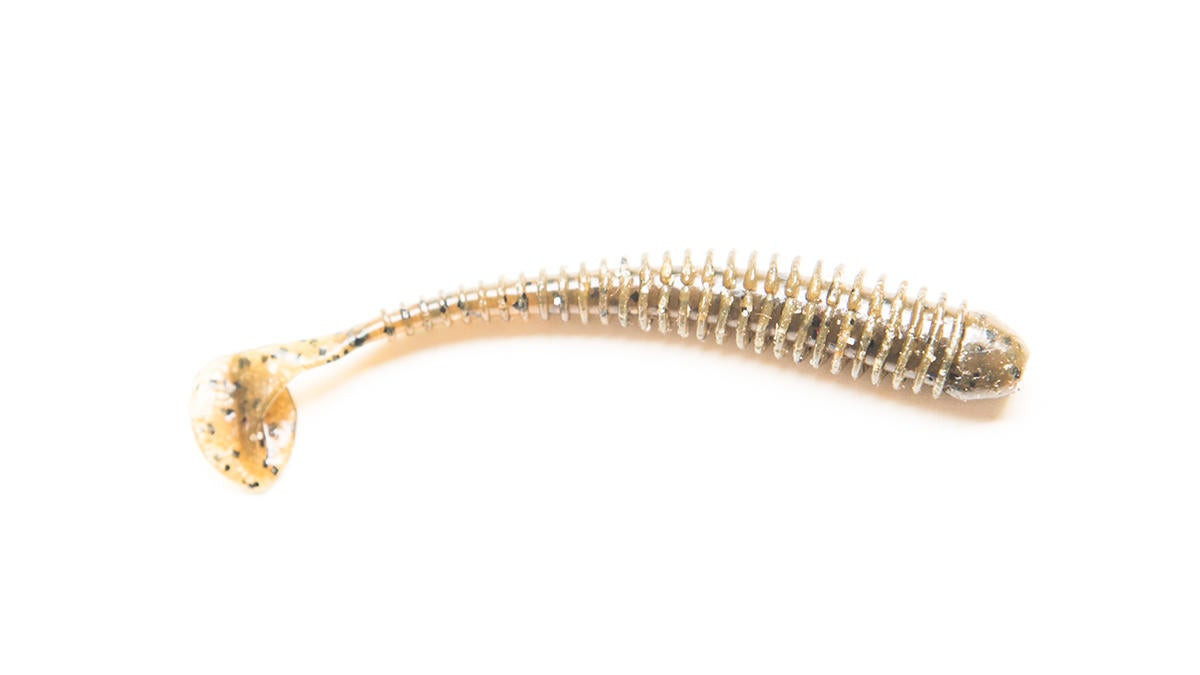
Keitech Swing Impact
Throughout much of the winter of 2019-20 and into the spring of 2020, Mike Czaplinski of Branchville, New Jersey, who is the proprietor of KeitechUSA, began informing us about several dainty soft-plastic baits that Midwest finesse anglers could add to their repertoire.
One of them is the 2 1/2-inch Swing Impact.
Czaplinski provided us with a package of them to work with and perhaps publish a gear guide about them.
Here is what we discovered about them.
It is what Midwest finesse anglers would describe as a super-finesse swimbait.
According to our measurements, it is 2 11/16 inches long when its paddle tail is fully extended.
Its head possesses an oval-shaped dome with a smooth epidermis. It is 3/16-inch long with a width of 3/16-inch at its widest spot and a circumference of about 7/8-inch. It has a height of 5/16-inch at its highest spot. At the tip of the head, there is a slight indentation, which is where a Midwest finesse angler will insert the hook and bait keeper of a small jig.
From its junction with its head to its junction with its tail, the torso is 2 3/16 inches long. It is encircled with 29 ribs. The torso is somewhat oval shaped. At rib number one, it is a 1/4-inch wide with a circumference of about 15/16-inch and a height of 5/16-inch. Rib number 10 is situated 1/2-inch from the tip of the head, and it has a width of a 1/4-inch, a height of 5/16-inch and a circumference of one inch. The circumference, height, and width of the torso diminishes in size between ribs number nine and 29. At rib number 29, which is adjacent to the beginning of the torso’s caudal peduncle area, the torso has a width of 1/16-inch, a height of 3/16-inch and a circumference of about 7/16-inch.
The caudal peduncle area is a 1/2-inch long with a smooth epidermis. It is thin and flat with a thickness of about 1/16-inch. Near the junction with rib number 29, the caudal peduncle has a height of 1/8-inch. At its junction with the Swing Impact’s paddle- or boot-style tail, the caudal peduncle possesses a flange-like shape with a height of 3/8-inch.
The tail is thin with a smooth epidermis. It has an oval shape. It has a height of 7/16-inch. It is 3/8-inch wide at its widest spot. It is about one millimeter thick.
It is manufactured in the following hues: Ayu, Bluegill Flash, Chartreuse Shad, Electric Blue Gill, Electric Shad, Green Pumpkin Candy, Green Pumpkin Chartreuse, Green Pumpkin Pepper, Male Perch, Morning Dawn, Pro Blue Red Pearl, Sexy Shad, Shad, Sight Flash, and Smallmouth Magic,
It is manufactured with a dual-injection molding process with two different salted plastics. It is buoyant and infused with a strong squid scent.
Besides the 2 1/2-incher, the Swing Impact is made in four other sizes. According to Czaplinski, the Swing Impact was created in 2009 by the late and great Kei Hayashi of Yamanashi, Japan. His first renditions were 3 1/2 inches and 4 inches long. The 3-inch model debuted in 2013. The 2-inch, 2 1/2-inch and 4 1/2-inch Swing Impacts were added to Keitech’s repertoire in 2015. And Czaplinski notes that nowadays the bass fishing world has finally “discovered the swimming attributes of the smaller sizes” of the Swing Impact.
A 2 1/2-inch soft-plastic bait affixed to a small jig with an exposed hook has played a dominant role in the repertoire of Midwest finesse fishing for decades. And in its infancy, the pioneers of Midwest finesse fishing were often belittled as “crappie fishing for bass” when they were seen by their power-fishing brethren using a rig the size of the 2 1/2-inch Swing Impact on a tiny jig. But those denunciations have subsided dramatically during the past three years.
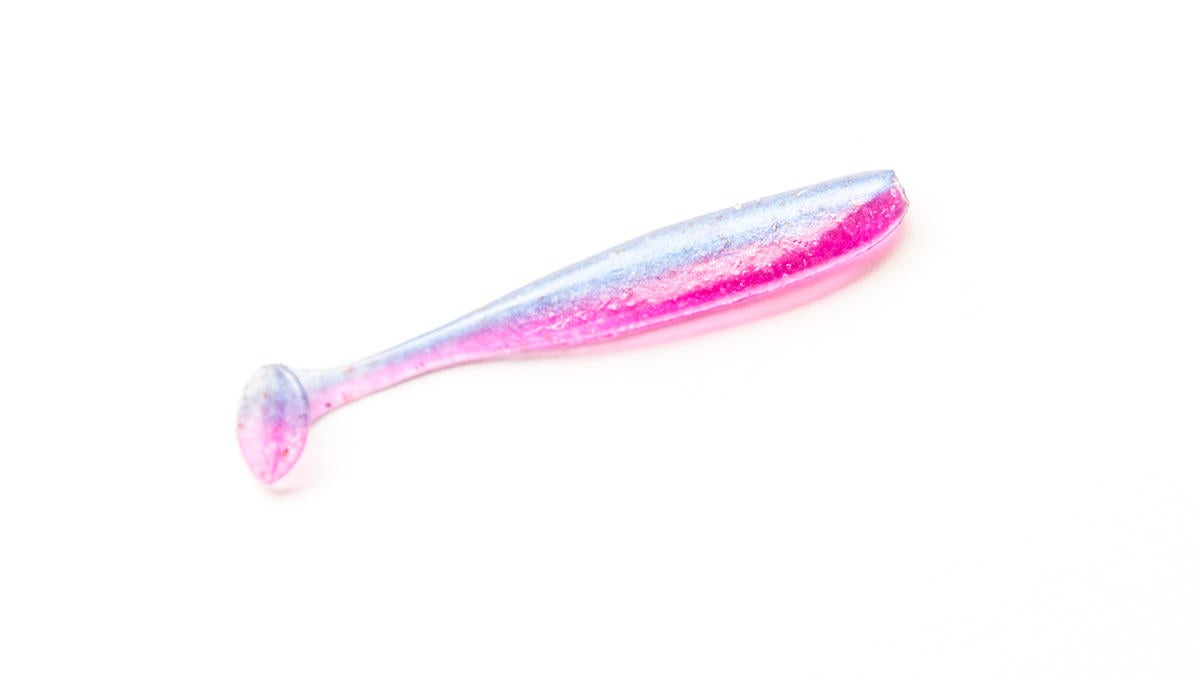
Keitech Easy Shiner
Mike Czaplinski of Branchville, New Jersey, who is the proprietor of KeitechUSA, introduced us to the Easy Shiner. It is one of the creations of the late and great Kei Hayashi of Yamanashi, Japan.
It is manufactured in seven sizes. An eight-incher is the largest, and the 2-incher is the smallest. The first Easy Shiner was 4 inches long, and it was created in 2009. The 2-incher was created in 2015,and in 2019, the 3 1/2- and 8-inch versions were added to Keitech’s repertoire.
For years on end, Midwest finesse anglers have exhibited a hankering for 2- to 3 1/2-inch soft-plastic baits. Therefore, Czaplinski sent us a 2-inch Easy Shiner to examine and publish a gear guide about it. In the eyes of most power anglers, the 2-inch Easy Shiner is a crappie bait, and for decades these anglers have light-heartily castigated Midwest finesse anglers for crappie fishing for largemouth bass, smallmouth bass and spotted bass. Despite those chastisements from our power-fishing brethren, we have inveigled untold numbers of black bass on our tiny Midwest finesse rigs.
Here is what we discovered about the 2-inch Easy Shiner.
It is a quintessential-looking swimbait, and according to our measurements, it is 2 3/16 inches long when its tail is fully extended.
The shape of its body abstractly mimics the characteristics of a variety of small fish, such as that of a chub, dace and shiner.
From the tip of its snout to the tip of its tail, its epidermis is entirely smooth.
Its dorsal is slightly convex and it is endowed with a hook slot that is 1 1/4 inches long. This slot begins at a 1/4-inch from the tip of its snout and it ends at an inch from the tip of its snout.
The dorsal area is 3/16-inch wide at its widest spot. Its sides are 5/16-inch high at their highest spot. The circumference at these spots is about 15/16-inch.
The ventral area is also slightly convex and it has a hook slot that is 1 3/8 inches long. This hook slot is slightly deeper and wider than the dorsal’s hook slot.
The posterior section of the Easy Shiner’s ventral area possesses an area that an anatomist would call the caudal peduncle. It stretches from the anus to its junction with the tail. The Easy Shiner’s caudal peduncle is about 3/4-inch long. The dimensions of the Easy Shiner’s torso diminishes significantly in the caudal peduncle region. For example, at 7/16-inch from the junction with the tail, the height of each side of the torso contracts to 1/8-inch, the width becomes 1/16-inch and the circumference is about 5/16-inch. But the height of the sides of the caudal peduncle area increases as it approaches its junction to the Easy Shiner’s paddle tail and its height becomes 1/4-inch at that junction.
The paddle tail has a height of 3/8-inch. It is 5/16-inch wide at its widest spot. The tail is thin with a thickness of less than 1/16-inch.
The Easy Shiner is available in the following hues: Bluegill Flash, Electric Bluegill, Electric Shad, Green Pumpkin Chartreuse, Morning Dawn, Pro Blue Pead Pearl, Sexy Shad. Shad, Sight Flash, and Smallmouth Magic. They are manufactured with what Keitech calls a custom two-tone color process.
It is enhanced with a strong squid scent.
They are manufactured with what KeitechUSA says is a “specific plastics densities for better balance and action,” which creates a “natural swimming action.”
It is not buoyant.
Czaplinski told us that the traditional black-bass fishermen have discovered “the swimming attributes of the smaller sizes” of the Easy Shiner. Thus, KeitechUSA is selling a surprising number of them.
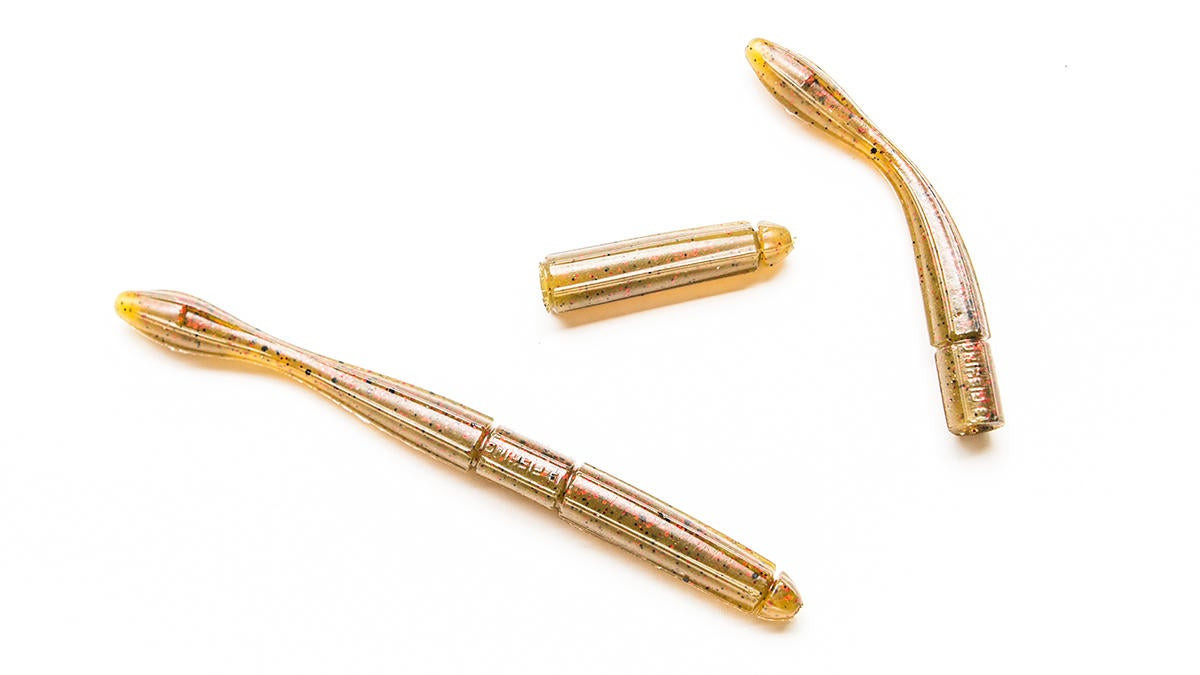
13 Fishing Bubble Butt
The soft-plastic-lure designers at 13 Fishing in Clearwater, Florida, have created a unique soft-plastic worm. It is called the Bubble Butt.
It was introduced to the angling world at the 2020 virtual International Convention of Allied Sportfishing Trades show. And Reid Miller, who is 13 Fishing’s Marketing Coordinator, provided us with some samples for us to work with and write about.
Here is what we discovered about it.
It is manufactured in two sizes: a 5-incher and a 6-incher. And this gear guide features the 5-inch model.
According to our measurements, it is 5 1/4 inches long.
Unlike an earthworm, its torso does not have a cylindrical shape and an array of segments. Instead, it has five sides and each side is demarcated by a small ridge. Except for the name 13 Fishing that is imprinted on one of the sides of the clitellum section, the epidermis between each ridge is smooth.
Its head is dramatically separated from the anterior section by an indented ring. The folks at 13 Fishing call it “a notched head.” It was designed so that power anglers can easily remove the head to allow a bullet-style slinker to fit perfectly flush to the Bubble Butt’s anterior section.
Its head is a quarter of an inch long. It has a dome shape that is almost 5/16-inch wide at its widest spot with a circumference of about one inch.
The anterior section is 2 5/8 inches long. At 1 3/4 inches from the tip of its head, there is an indented ring and at 2 9/16 inches from the tip of its head there is another indented ring. These indentations create a 5/8-inch section that is somewhat similar to an earthworm’s clitellum or egg sack. These two rings are identical to the ring that demarcates the head. According to 13 Fishing description of the Bubble Butt, these “two small ring cutouts on the body that are perfect for installing an O-ring for a wacky-rig.”
The width of the anterior section near the first indented ring is about 3/8-inch with a circumference of about 1 1/8 inches. Near the second indented ring, its torso has a width of about 7/16-inch and a circumference of about 1 1/4 inches.
In the middle portion of the clitellum, the width is about 7/16-inch with a circumference of about 1 1/4 inches.
Near the junction of the anterior and posterior sections, the width of the posterior section is about 7/16-inch with a circumference of about 1 1/4 inches.
As the posterior section approaches its junction with the Bubble Butt’s tail, the dimensions of the torso diminish significantly. At 1 5/16 inches from the tip of its tail, the torso has a width of about 1/4-inch and circumference of about 11/16-inch.
The tail is one inch long with a width of about 3/8-inch at its widest spot and a circumference of 1 1/8 inches. Like the Bubble Butt’s head and torso, the tail has five sides that are delineated by six ridges. Some folks say it has the shape of a football and others say it looks like a snake’s head. It is endowed with an air pocket. This air pocket was designed to allow the Bubble Butt’s tail to rise up from the bottom when anglers execute a deadstick presentation or drag-and-shake presentation. Anglers can also fill the air bubble with scent or a rattle.
It is available in the following hues: Black & Tan, Blackberry Cobbler, Blackberry Cobbler Blue, Blueberry Yum Yum, Collard Green Neon, Collard Greens, Mardi Craw, OG Sour, Smoke and Mirrors, and Witches Brew.
It is impregnated with salt and a scent that is called Donkey Sauce.
It is not buoyant, but the air pocket allows the tail to become elevated.
The Bubble Butt was created for power anglers. But Midwest finesse anglers have always had a propensity to customize soft-plastic baits that are made for their power-fishing colleagues. Thus, they will shorten the Bubble Butt by removing portions of the anterior section to create either a 4-inch or 3 1/2-inch version of the Bubble Butt and affix it to a small mushroom-style jig with an exposed hook. This will allow them to catch largemouth bass, smallmouth bass and spotted bass by employing all six of the standard Midwest finesse retrieves or slight variations of those retrieves.
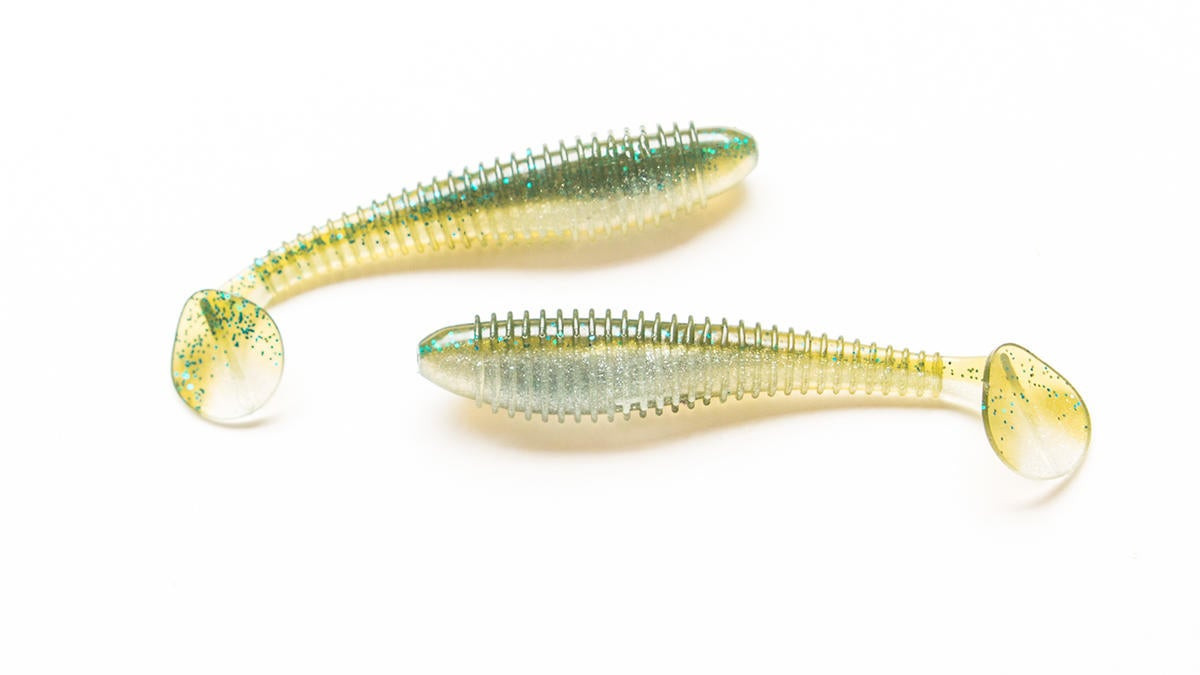
Big Bite Baits Pro Swimmer
Big Bite Baits have added two finesse-sizes to their Pro Swimmer repertoire, and it immediately caught the attention of several Midwest finesse anglers.
To assist us in publishing a Midwest Finesse gear guide about them, Scotty Petersen of Oakdale, Minnesota, who is Big Bite Baits’ media coordinator, sent us a few of the 2.8-inch and 3.3-inch Pro Swimmers.
Here is what we learned.
Because we are hard-headed finesse anglers, we opted to work with the smallest one. According to our measurements, when the 2.8-inch Pro Swimmer is measured along its dorsal area, it is 2 3/4 inches long. And when it is measured along its ventral area and the tip of its tail is fully extended, it is 3 1/4 inches long.
The head and predorsal area are somewhat dome-shaped. It is 1/4-inch long and 3/8-inch wide at its widest spot with a circumference of 1 1/16 inches. Its epidermis is smooth but the tip of the head is graced with a small indentation, which has a diameter of about 1/8-inch. This indentation is where Midwest finesse anglers will insert the hook and collar or hook keeper of a mushroom-style jig.
Two-and-three-sixteenths inches of Pro Swimmer’s body are encircled with 29 significant ribs.
The first 1 1/8 inches of its dorsal area is somewhat flat. It is endowed with a hook slot that is 15/16-inch long and slightly more than 1/16-inch wide. It is also graced with 16 ribs and thirteen of them are separated by the hook slot. At its widest spot, the dorsal is about 7/16-inch wide. This wide spot is situated from 5/16-inch to 13/16-inch from the tip of the head. The entire body at this spot has a circumference of about 1 5/8 inches. This 1 1/8-inch section and the head constitute the anterior portions of this Pro Swimmer.
The next inch of the dorsal area becomes slightly convex. Its width diminishes significantly, shrinking from a width of 1/4-inch to about 1/8-inch. It is endowed with 13 ribs. This 1-inch section and the tail or caudal are the Pro Swimmer’s posterior section.
Its entire ventral area is convex and 2 5/8 inches of it is embellished with 29 ribs. The ventral’s first 1 1/8 inches is adorned with 16 ribs and six of them are separated by a hook slot that is 7/16-inch long and about 1/16-inch wide.
The next 1 1/16 inches of the ventral, which is part of its posterior section, becomes vividly smaller. Anatomists describe this area of the posterior section as being the caudal peduncle.
The circumference of the body at ribs number one and two is 1 5/8 inches. At rib number 16, the circumference is 1 1/4 inches. At rib number 29, the circumference diminishes to 11/16-inch.
The final element of the posterior section is endowed with a thin and flat flange-like fixture and a tail. The flange’s dorsal is straight and 3/8-inch long with a thickness of 1/16-inch. The flange’s ventral is curved and about 3/4-inch long with a thickness of 1/16-inch. At the flange’s junction with rib number 29, it has a height of about 3/16-inch. The height at the flange’s junction with the tail is about 11/16-inch. The flange’s epidermis is smooth.
The flange is adorned with a paddle-like tail, which some anglers call a boot. It exhibits somewhat of the shape of a cordate leaf. From the top of the paddle to its bottom, which is called its major axis, it is 13/16-inch long. It is 3/4-inch wide at its widest spot. It is thin and about 1/16-inch thick. It has a circumference of about 2 5/8 inches. The epidermis is smooth.
Except for the two hook slots, the entire body is solid. It is buoyant and impregnated with a scent that is called Bite Juice.
It is available in the following hues: Albino, Baby Bass, Lavender Shad, Pearl, Pearl Shiner, Pro Blue Red Pearl, Shad, Silver Shiner, Smoky Gold/Clear Silver and Sunfish.
Find them here:
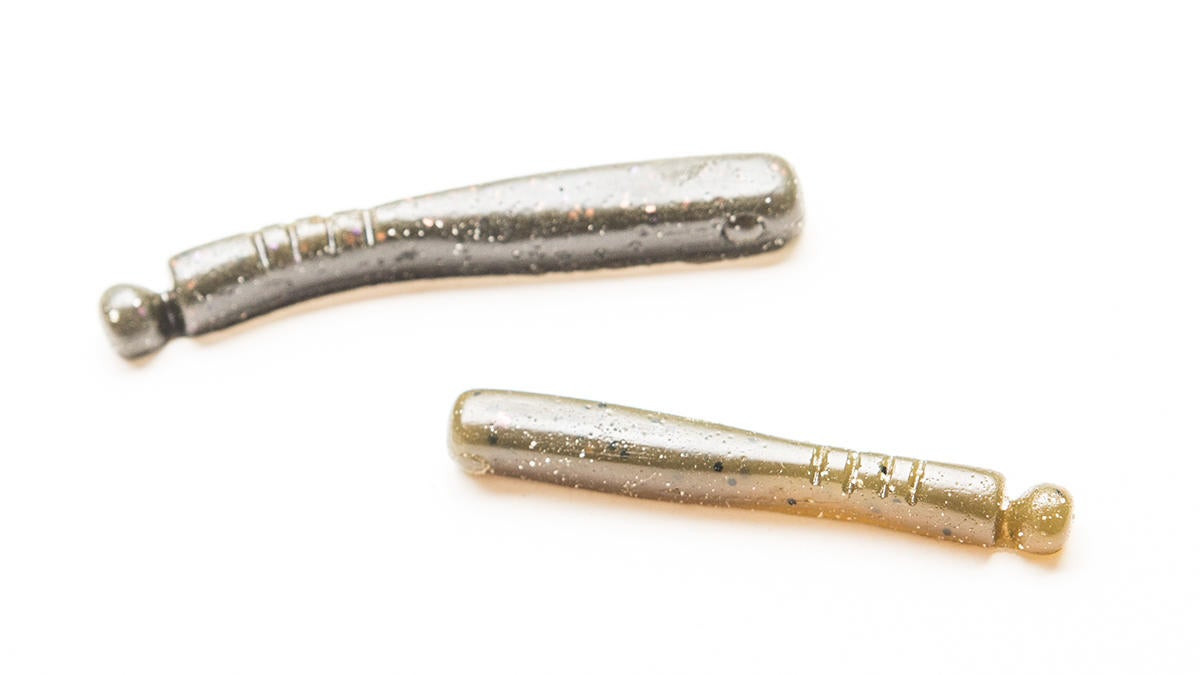
Venture Lures Dropper
In December of 2019, we began corresponding periodically with Michael Simonton of Berlin Heights, Ohio.
He is the proprietor of Venture Lures, which he opened in January of 2018. It is a venue that allows him to sell his handcrafted soft-plastic finesse baits that he began designing and making in 2016. He originally made them only for himself and the anglers that he guided on Lake Erie. Now he has become such an efficient and productive craftsman that other anglers can acquire them.
One of those baits is his Dropper, which is manufactured in two sizes: 2 3/4 inches and 3 1/4 inches.
Simonton told us that he designed it with a flat ventral area in order to stabilize or prevent it from rolling from side to side as a soft-plastic bait with a concave ventral area rolls as an angler retrieves it. He also explained that a Dropper affixed to a drop-shot rig has “very little inherent action or movement,” which he says “can be key some days.”
Although it was originally designed to be affixed to a drop-shot rig, Simonton and his colleagues have subsequently discovered that it is potent when it is affixed to a jig, which is the way Midwest finesse anglers will employ it.
Here is what we discovered about the 2 3/4-incher.
According to our measurements, it is 2 5/8 inches long.
Its anterior section is about 1 1/4 inches long.
The first 5/16-inch of the anterior section, which is its head, is adorned with two eyes. At its widest spot, it is 3/8-inch wide with a height of about 1/4-inch and a circumference of 1 3/16 inches and this area is situated about 3/16-inch from the tip of the head. The tip of the head is flat. Its dorsal is convex and its ventral is flat.
The dimensions of the anterior section become smaller as it approaches its junction with the posterior section. Near this junction, its width is slightly less than 5/16-inch with a height of about 5/16-inch and a circumference of about 1 1/16 inches.
Except for its two eyes and several pockmarks, the epidermis of the anterior’s sides and convex dorsal area is smooth. Its flat ventral area is almost glassy.
Its posterior section is 1 5/16 inches long. It is somewhat similar to the caudal peduncle of a fish.
It is tipped with a knob-shaped tail that is about 3/16-inch long. At its widest spot, it is about 5/16-inch wide with a height of about 1/4-inch and a circumference of 15/16-inch.
The junction of the tail to the rest of the Dropper’s posterior section is quite dramatic, exhibiting a gap of about one-eighth of an inch.
At the junction with the tail and the junction to the anterior section, the shape of the posterior section is somewhat similar to an hourglass. Its dorsal is convex and adorned with three significant ribs. Near the junction with the tail, it has a width of 5/16-inch with a height of slightly less than 5/16-inch and circumference of 1 1/16 inches.
The posterior’s smallest area is situated around its first rib, which is situated about 3/8-inch from the junction of the anterior and posterior sections. It has a width of 1/4-inch with a height of about 5/16-inch and a circumference of about 15/16-inch.
The anatomical features of the 3 1/4-inch Dropper are identical to its smaller sibling. Of course, its features are bigger. For example, its head is about 1/2-inch long and it is about 7/16-inch wide at its widest spot with a height of about 5/16-inch and a circumference of about 1 1/8 inches. This wide spot is 5/16-inch from the tip of its head. Its knob-shaped tail is about 5/16-inch long and 3/8-inch wide at it widest spot with a height of about 5/16-inch and a circumference of about 1 1/8 inches.
They are available in the following hues: Green Pumpkin, Green Pumpkin OC, Green Pumpkin P, Green Pumpkin PBC, and Morning Dawn.
They are infused with salt and garlic. They are very buoyant.
In the eyes of Midwest finesse anglers, the Dropper is a highly sculptured version of the angling world’s first stick-style bait, which Chuck Woods of Kansas City, Missouri, created in the late 1950s and early 1960s. Thus, today’s Midwest finesse anglers will present the Dropper to their black-bass quarries the same way that Chuck Woods and the other forefathers of Midwest finesse fishing used a stick-style bait.
Simonton mentioned that the Dropper has very little inherent action or movement when it was employed on a drop-shot rig. But when Midwest finesse anglers affix it to a small mushroom-style jig with a small and exposed hook, its posterior section will undulate quite dramatically at times when we employ several of our Midwest finesse retrieves. What’s more, the Dropper’s buoyancy and flat ventral section will enhance the gliding motif when Midwest finesse anglers employ the swim-glide-and-shake presentation.
You can find the Venture Lures Dropper here.
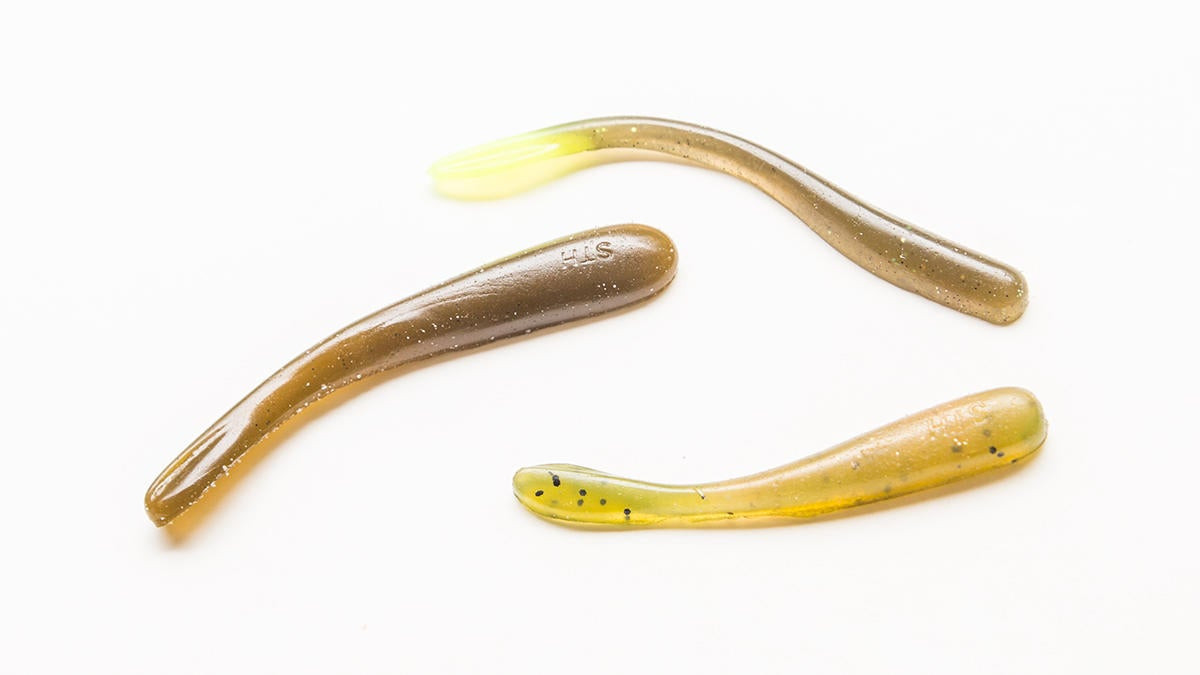
NetBait STH Finesse Series Crush Worm
Shortly after American Baitworks Company of Ocean Springs, Mississippi, introduced its Netbait STH Finesse Series Crush Worm to the angling world during the 2020 virtual International Convention of Allied Sportfishing Trades show, we exchanged several emails with Justin Sward. He is the company’s Chief Administrative Officer, and we told him that we would like to publish a gear guide about this series.
And he kindly provided us with some details about American Baitworks. He also sent us several samples of the series for us to work with, thoroughly examine, and write about.
Here is what we discovered about the NetBait STH Finesse Series.
In a Sept. 10 email, Sward wrote that the NetBait STH Finesse Series revolves around a partnership between American Baitworks and Peter Savoia, who is the proprietor of Set the Hook Bait Company of Newmarket, Ontario, Canada. And Set the Hook Bait Company has become part of a consortium of six tackle companies that American Baitworks manages. This allows NetBait, which is part of the consortium, to market and sell in the United States a few of the soft-plastic finesse baits that Savoia manufactures in Canada.
Sward acknowledged in an email that NetBait “was missing a serious finesse series of products.” But “during the formation of American Baitworks we saw a fantastic opportunity to partner with STH and use their expertise of the finesse market to push out this series for NetBait. Peter Savoia … has extensive knowledge and experience in the finesse market and his products have been used for years by all the top level pros, unfortunately he never got the recognition he deserved and the brand couldn’t get much traction in the US market. Our plans are to change that now with the products … promoted by NetBait in the US.”
There are three soft-plastic worms in the Crush Worm series. One is the 3-inch Junior Crush Worm. The second one is the 3 1/2-inch Stumpy Crush Worm. The third one is the 3 3/4-inch Crush Worm.
They are touted as being “made of the finest hand-poured plastics.” The plastic is also described as being a “super soft high floating plastic.”
In the eyes of Midwest finesse anglers, they exhibit the demeanor of a very abstract minnow or fish rather than a worm. We might describe them as a round-goby-shaped worm, and in some ways, they are similar to the shad-shaped worm that Shin Fukae of Osaka, Japan, introduced to Midwest finesse anglers on April 1, 2006, at Beaver Lake, Arkansas.
Therefore, we will describe the anatomy of the Junior Crush Worm and its siblings as a minnow rather than a worm.
According to our measurements, the Junior Crush Worm is 3 1/16 inches long.
Its anterior section is slightly longer than 1 1/2 inches.
Near the tip of its snout or predorsal section, it has a width of about 5/16-inch, a height or depth of about 1/4-inch and a circumference of about 1 1/8 inches. The tip of its snout has somewhat of a round shape but its ventral area is flat. The entire epidermis of its snout is smooth.
At 1/2-inch from the tip of its snout, this part of its anterior section has a width of 7/16-inch, a height or depth of about 5/16-inch and a circumference of about 1 1/4 inches.
The size of the anterior section gradually diminishes as it approaches the junction with its posterior section, and at one inch from the tip of its snout and 9/16-inch from its posterior section, the anterior has a width of 3/8-inch, a height or depth of about a quarter of an inch and a circumference of about 1 1/8 inches.
The anterior section’s dorsal section is convex. Its ventral area is basically flat, but there are spots where it is slightly concave. Except for the capital letters STH that are imprinted on its dorsal area, the anterior’s entire epidermis is smooth.
At the junction of the anterior and posterior sections, the Junior Crush Worm has a width of slightly less than 1/4-inch, a height or depth of slightly less than a 1/4-inch and a circumference of about 15/16-inch.
The smallest portion of the Junior Crush’ Worm’s posterior is situated at 5/16-inch from its junction with the anterior section and 1 3/16 inches from the tip of its tail or caudal. In the lingo of fisheries biologists and anatomists, this area of a fish or minnow is described as the caudal peduncle, and it is the narrowest region of a fish’s body. It has a width of about 3/16-inch, a height or depth of slightly less than 3/16-inch and a circumference of about 13/16-inch.
The dorsal area of the first 13/16-inch of the posterior is convex and its ventral area is flat. The entire epidermis of this stretch is smooth.
The final 13/16-inch of the posterior section has a different shape and it sports the Junior Crush Worm’s tail, which exhibits an elliptical shape. Its dorsal area is no longer convex; instead, it is somewhat flat and endowed with a ridge. Its is 3/8-inch wide at its widest spot with a height or depth of about 3/8-inch.
Here is a brief description of what we discovered about the Junior Crush Worm’s siblings.
The Stumpy Crush Worm possesses a beefier circumference, width, and depth than the Junior Crush Worm. It is also longer. According to our measurements, it is exactly 3 1/2 inches long. The shape of its tail’s dorsal area is identical to the Junior Crush Worm’s tail. The shape of its head and the dorsal areas of its anterior and posterior sections match those of its junior sibling. The only difference between the two is the characteristics of the Stumpy Crush Worm’s ventral area. The Junior’s ventral has several concave spots but the Stumpy’s entire ventral area is slightly concave. And in the eyes of most Midwest finesse anglers, a slightly concave ventral will accentuate its ability to glide when these anglers employ a swim-glide-and-shake retrieve.
The 3 3/4-inch Crush Worm is longer than both of its siblings. Our measurements revealed that it is 3 7/8 inches long. It also exhibits a slimmer profile. And some portions of its anterior and posteriors areas have a slightly smaller circumference, width and depth in some spots than the Junior Crush Worm. Compared to the Junior Crush Worm and Stumpy Crush Worm, the 3 3/4-inch Crush Worm’s slenderness allows it to possess more of the characteristics of a soft-plastic worm than its siblings possess.
They are available in the following hues: Bang, Dark Smelt, Green Pumpkin, Grey Ghost, Juvenile Goby Pearl, Killer Pumpkin, LON Goby Pearl, Magic Chart, Midnight Green, Naked Perch, Smokin Joe, and White.
They are buoyant and impregnated with salt and scent.
The Netbait STH Finesse Series Crush Worm is lauded as an “ideal drop shot bait.” But Midwest finesse anglers will rig them on a small mushroom-style jig with an exposed hook. The reason why they prefer rigging it on a mushroom-style jig stems from the fact that a drop-shot rig isn’t as effective for inveigling largemouth bass and smallmouth bass in the waterways that these anglers normally fish.
Find them here:












